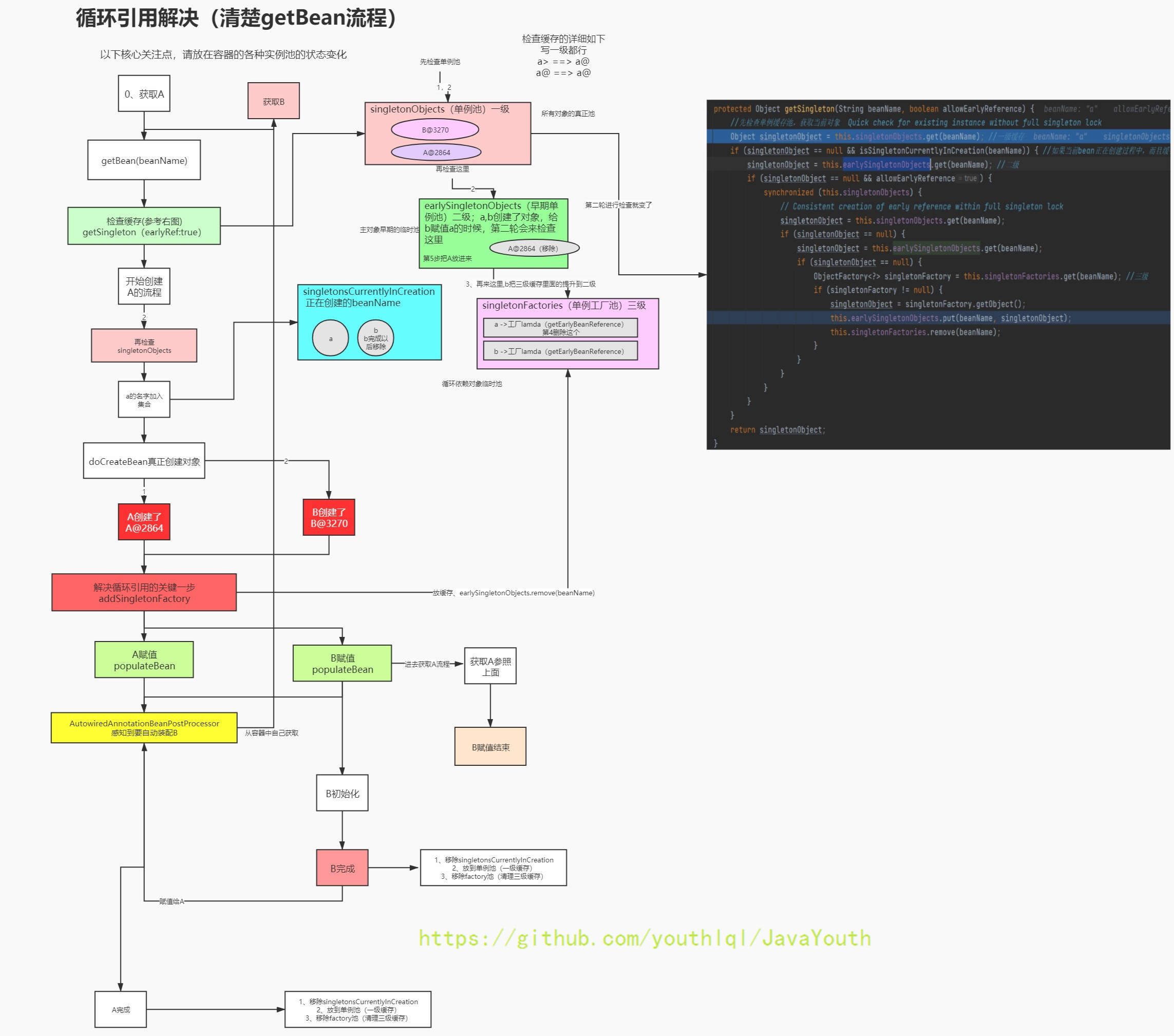第5章-容器刷新流程
流程图-容器刷新
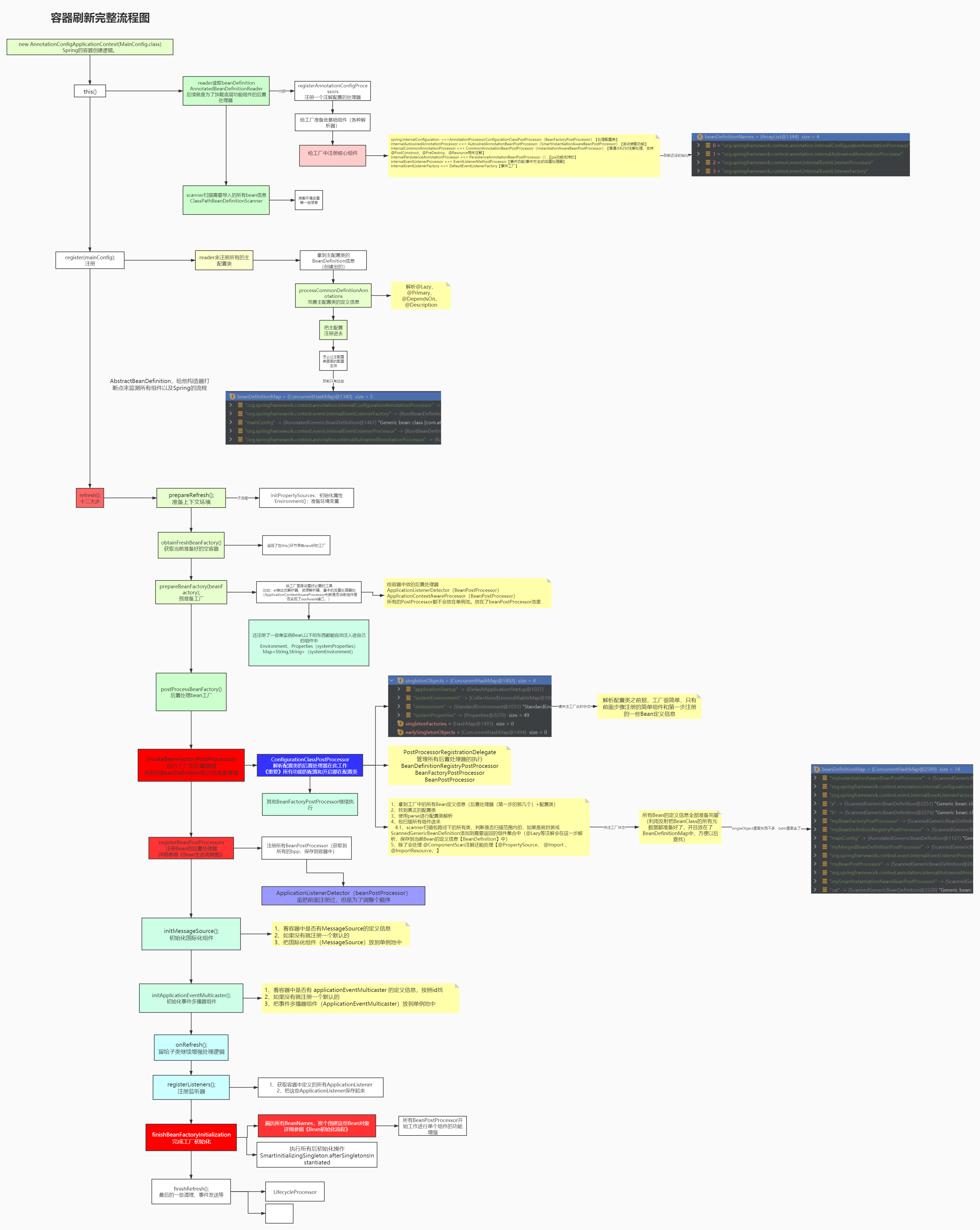
容器创建
public class AnnotationMainTest {
public static void main(String[] args) {
ApplicationContext applicationContext =
new AnnotationConfigApplicationContext(MainConfig.class);
}
AnnotationConfigApplicationContext有参构造
public AnnotationConfigApplicationContext(Class<?>... componentClasses) {
this();
register(componentClasses);
refresh(); //容器完整刷新(创建出所有组件,组织好所有功能)
}
AnnotationConfigApplicationContext#this()无参构造
// 上面的this()就是调用的这里
public AnnotationConfigApplicationContext() {
StartupStep createAnnotatedBeanDefReader = this.getApplicationStartup().start("spring.context.annotated-bean-reader.create");
this.reader = new AnnotatedBeanDefinitionReader(this);
createAnnotatedBeanDefReader.end();
this.scanner = new ClassPathBeanDefinitionScanner(this);
}
AnnotatedBeanDefinitionReader有参构造
public AnnotatedBeanDefinitionReader(BeanDefinitionRegistry registry) {
this(registry, getOrCreateEnvironment(registry));
}
public AnnotatedBeanDefinitionReader(BeanDefinitionRegistry registry, Environment environment) {
Assert.notNull(registry, "BeanDefinitionRegistry must not be null");
Assert.notNull(environment, "Environment must not be null");
this.registry = registry;
this.conditionEvaluator = new ConditionEvaluator(registry, environment, null);
AnnotationConfigUtils.registerAnnotationConfigProcessors(this.registry);
}
AnnotationConfigUtils#registerAnnotationConfigProcessors()注册Spring内部几个核心组件
/**
* The bean name of the internally managed Configuration annotation processor.
*/
public static final String CONFIGURATION_ANNOTATION_PROCESSOR_BEAN_NAME =
"org.springframework.context.annotation.internalConfigurationAnnotationProcessor";
/**
* The bean name of the internally managed BeanNameGenerator for use when processing
* {@link Configuration} classes. Set by {@link AnnotationConfigApplicationContext}
* and {@code AnnotationConfigWebApplicationContext} during bootstrap in order to make
* any custom name generation strategy available to the underlying
* {@link ConfigurationClassPostProcessor}.
* @since 3.1.1
*/
public static final String CONFIGURATION_BEAN_NAME_GENERATOR =
"org.springframework.context.annotation.internalConfigurationBeanNameGenerator";
/**
* The bean name of the internally managed Autowired annotation processor.
*/
public static final String AUTOWIRED_ANNOTATION_PROCESSOR_BEAN_NAME =
"org.springframework.context.annotation.internalAutowiredAnnotationProcessor";
/**
* The bean name of the internally managed Required annotation processor.
* @deprecated as of 5.1, since no Required processor is registered by default anymore
*/
@Deprecated
public static final String REQUIRED_ANNOTATION_PROCESSOR_BEAN_NAME =
"org.springframework.context.annotation.internalRequiredAnnotationProcessor";
/**
* The bean name of the internally managed JSR-250 annotation processor.
*/
public static final String COMMON_ANNOTATION_PROCESSOR_BEAN_NAME =
"org.springframework.context.annotation.internalCommonAnnotationProcessor";
/**
* The bean name of the internally managed JPA annotation processor.
*/
public static final String PERSISTENCE_ANNOTATION_PROCESSOR_BEAN_NAME =
"org.springframework.context.annotation.internalPersistenceAnnotationProcessor";
private static final String PERSISTENCE_ANNOTATION_PROCESSOR_CLASS_NAME =
"org.springframework.orm.jpa.support.PersistenceAnnotationBeanPostProcessor";
/**
* The bean name of the internally managed @EventListener annotation processor.
*/
public static final String EVENT_LISTENER_PROCESSOR_BEAN_NAME =
"org.springframework.context.event.internalEventListenerProcessor";
/**
* The bean name of the internally managed EventListenerFactory.
*/
public static final String EVENT_LISTENER_FACTORY_BEAN_NAME =
"org.springframework.context.event.internalEventListenerFactory";
public static void registerAnnotationConfigProcessors(BeanDefinitionRegistry registry) {
registerAnnotationConfigProcessors(registry, null);
}
public static Set<BeanDefinitionHolder> registerAnnotationConfigProcessors(
BeanDefinitionRegistry registry, @Nullable Object source) {
DefaultListableBeanFactory beanFactory = unwrapDefaultListableBeanFactory(registry);
if (beanFactory != null) {
if (!(beanFactory.getDependencyComparator() instanceof AnnotationAwareOrderComparator)) {
beanFactory.setDependencyComparator(AnnotationAwareOrderComparator.INSTANCE);
}
if (!(beanFactory.getAutowireCandidateResolver() instanceof ContextAnnotationAutowireCandidateResolver)) {
beanFactory.setAutowireCandidateResolver(new ContextAnnotationAutowireCandidateResolver());
}
}
//下面是注册Spring底层的核心组件,主要是就是Spring自己的BeanPostproPostProcessor或者BeanFactoryPostProcessor
Set<BeanDefinitionHolder> beanDefs = new LinkedHashSet<>(8);
//注册底层的 配置文件处理器
if (!registry.containsBeanDefinition(CONFIGURATION_ANNOTATION_PROCESSOR_BEAN_NAME)) {
RootBeanDefinition def = new RootBeanDefinition(ConfigurationClassPostProcessor.class);
def.setSource(source);
beanDefs.add(registerPostProcessor(registry, def, CONFIGURATION_ANNOTATION_PROCESSOR_BEAN_NAME));
}
//注册底层的自动装配处理器
if (!registry.containsBeanDefinition(AUTOWIRED_ANNOTATION_PROCESSOR_BEAN_NAME)) {
RootBeanDefinition def = new RootBeanDefinition(AutowiredAnnotationBeanPostProcessor.class);
def.setSource(source);
beanDefs.add(registerPostProcessor(registry, def, AUTOWIRED_ANNOTATION_PROCESSOR_BEAN_NAME));
}
//注册支持JSR-250的处理
// Check for JSR-250 support, and if present add the CommonAnnotationBeanPostProcessor.
if (jsr250Present && !registry.containsBeanDefinition(COMMON_ANNOTATION_PROCESSOR_BEAN_NAME)) {
RootBeanDefinition def = new RootBeanDefinition(CommonAnnotationBeanPostProcessor.class);
def.setSource(source);
beanDefs.add(registerPostProcessor(registry, def, COMMON_ANNOTATION_PROCESSOR_BEAN_NAME));
}
// Check for JPA support, and if present add the PersistenceAnnotationBeanPostProcessor.
if (jpaPresent && !registry.containsBeanDefinition(PERSISTENCE_ANNOTATION_PROCESSOR_BEAN_NAME)) {
RootBeanDefinition def = new RootBeanDefinition();
try {
def.setBeanClass(ClassUtils.forName(PERSISTENCE_ANNOTATION_PROCESSOR_CLASS_NAME,
AnnotationConfigUtils.class.getClassLoader()));
}
catch (ClassNotFoundException ex) {
throw new IllegalStateException(
"Cannot load optional framework class: " + PERSISTENCE_ANNOTATION_PROCESSOR_CLASS_NAME, ex);
}
def.setSource(source);
beanDefs.add(registerPostProcessor(registry, def, PERSISTENCE_ANNOTATION_PROCESSOR_BEAN_NAME));
}
if (!registry.containsBeanDefinition(EVENT_LISTENER_PROCESSOR_BEAN_NAME)) {
RootBeanDefinition def = new RootBeanDefinition(EventListenerMethodProcessor.class);
def.setSource(source);
beanDefs.add(registerPostProcessor(registry, def, EVENT_LISTENER_PROCESSOR_BEAN_NAME));
}
if (!registry.containsBeanDefinition(EVENT_LISTENER_FACTORY_BEAN_NAME)) {
RootBeanDefinition def = new RootBeanDefinition(DefaultEventListenerFactory.class);
def.setSource(source);
beanDefs.add(registerPostProcessor(registry, def, EVENT_LISTENER_FACTORY_BEAN_NAME));
}
return beanDefs;
}
上面的方法走完,我们可以看看到主要是下面4个后置处理器
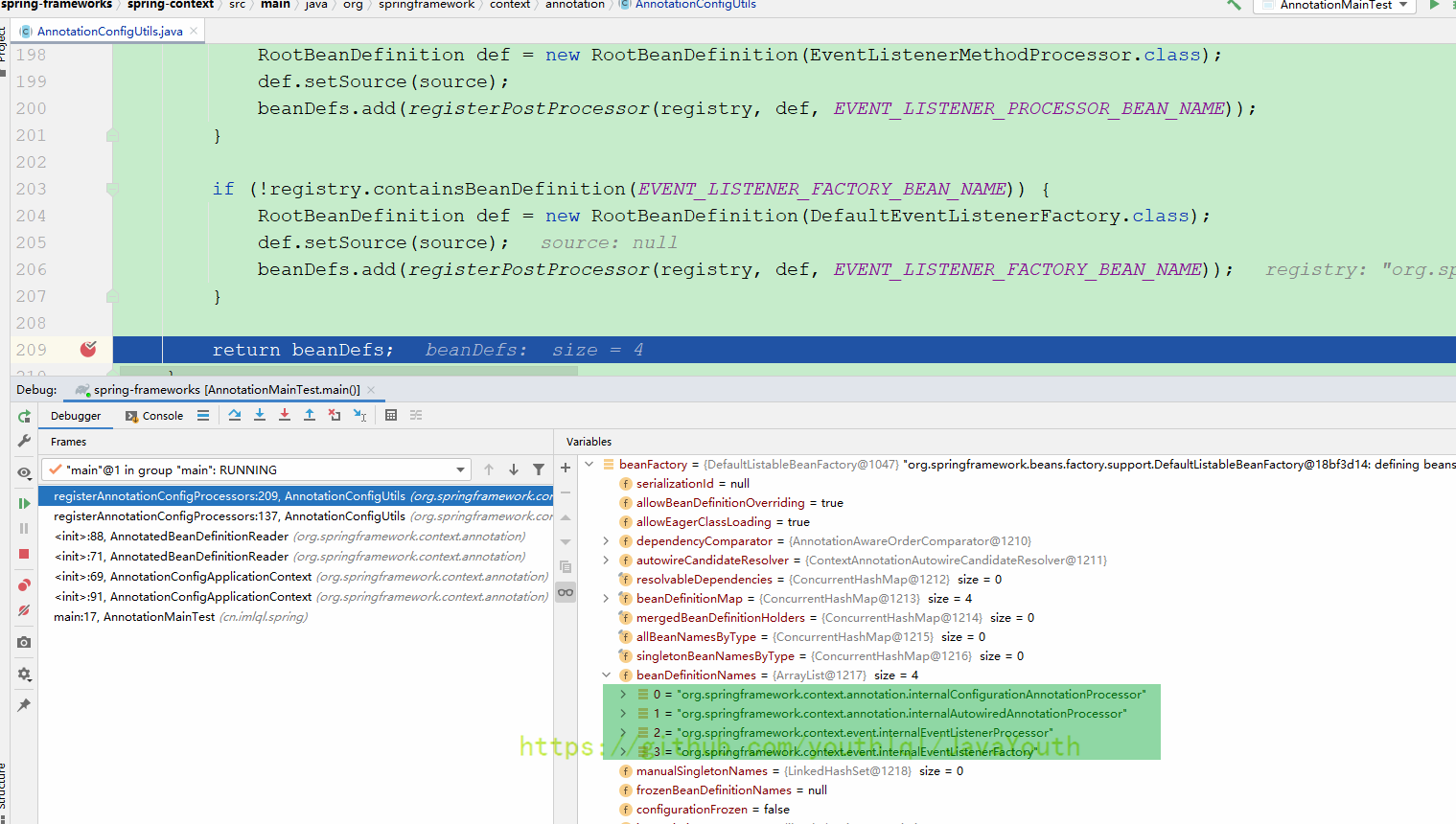
RootBeanDefinition
public RootBeanDefinition(@Nullable Class<?> beanClass) {
super();
setBeanClass(beanClass);
}
AbstractBeanDefinition
protected AbstractBeanDefinition() {
this(null, null);
}
ClassPathBeanDefinitionScanner
public ClassPathBeanDefinitionScanner(BeanDefinitionRegistry registry, boolean useDefaultFilters,
Environment environment, @Nullable ResourceLoader resourceLoader) {
Assert.notNull(registry, "BeanDefinitionRegistry must not be null");
this.registry = registry;
if (useDefaultFilters) {
registerDefaultFilters();
}
setEnvironment(environment); //准备环境
setResourceLoader(resourceLoader);//准备资源加载器
}
AnnotationConfigApplicationContext#register()
public void register(Class<?>... componentClasses) {
//componentClasses就是咱们的配置类
Assert.notEmpty(componentClasses, "At least one component class must be specified");
StartupStep registerComponentClass = this.getApplicationStartup().start("spring.context.component-classes.register")
.tag("classes", () -> Arrays.toString(componentClasses));
this.reader.register(componentClasses);
registerComponentClass.end();
}
AnnotatedBeanDefinitionReader#register()注册主配置类BeanDefinition
public void register(Class<?>... componentClasses) {
for (Class<?> componentClass : componentClasses) {
registerBean(componentClass);
}
}
public void registerBean(Class<?> beanClass) {
doRegisterBean(beanClass, null, null, null, null);
}
private <T> void doRegisterBean(Class<T> beanClass, @Nullable String name,
@Nullable Class<? extends Annotation>[] qualifiers, @Nullable Supplier<T> supplier,
@Nullable BeanDefinitionCustomizer[] customizers) {
// 主配置类也被封装成一个Bean定义信息了
AnnotatedGenericBeanDefinition abd = new AnnotatedGenericBeanDefinition(beanClass);
if (this.conditionEvaluator.shouldSkip(abd.getMetadata())) {
return;
}
abd.setInstanceSupplier(supplier);
ScopeMetadata scopeMetadata = this.scopeMetadataResolver.resolveScopeMetadata(abd);
abd.setScope(scopeMetadata.getScopeName());
String beanName = (name != null ? name : this.beanNameGenerator.generateBeanName(abd, this.registry));
//完善主配置类的BeanDefinition
AnnotationConfigUtils.processCommonDefinitionAnnotations(abd);
if (qualifiers != null) {
for (Class<? extends Annotation> qualifier : qualifiers) {
if (Primary.class == qualifier) {
abd.setPrimary(true);
}
else if (Lazy.class == qualifier) {
abd.setLazyInit(true);
}
else {
abd.addQualifier(new AutowireCandidateQualifier(qualifier));
}
}
}
if (customizers != null) {
for (BeanDefinitionCustomizer customizer : customizers) {
customizer.customize(abd);
}
}
BeanDefinitionHolder definitionHolder = new BeanDefinitionHolder(abd, beanName);
definitionHolder = AnnotationConfigUtils.applyScopedProxyMode(scopeMetadata, definitionHolder, this.registry);
BeanDefinitionReaderUtils.registerBeanDefinition(definitionHolder, this.registry);
}
AnnotationConfigUtils#processCommonDefinitionAnnotations()感知@Lazy,@Primary等注解
这里传进来的是主配置类,解析的就是主配置类的注解,其它的Bean这里还没有解析@Lazy,@Primary这些注解
public static void processCommonDefinitionAnnotations(AnnotatedBeanDefinition abd) {
processCommonDefinitionAnnotations(abd, abd.getMetadata());
}
//解读所有Bean定义信息需要感知的注解
static void processCommonDefinitionAnnotations(AnnotatedBeanDefinition abd, AnnotatedTypeMetadata metadata) {
AnnotationAttributes lazy = attributesFor(metadata, Lazy.class);
if (lazy != null) {
abd.setLazyInit(lazy.getBoolean("value"));
}
else if (abd.getMetadata() != metadata) {
lazy = attributesFor(abd.getMetadata(), Lazy.class);
if (lazy != null) {
abd.setLazyInit(lazy.getBoolean("value"));
}
}
if (metadata.isAnnotated(Primary.class.getName())) {
abd.setPrimary(true);
}
AnnotationAttributes dependsOn = attributesFor(metadata, DependsOn.class);
if (dependsOn != null) {
abd.setDependsOn(dependsOn.getStringArray("value"));
}
AnnotationAttributes role = attributesFor(metadata, Role.class);
if (role != null) {
abd.setRole(role.getNumber("value").intValue());
}
AnnotationAttributes description = attributesFor(metadata, Description.class);
if (description != null) {
abd.setDescription(description.getString("value"));
}
}
走完之后,注册中心肯定多了咱们的配置类
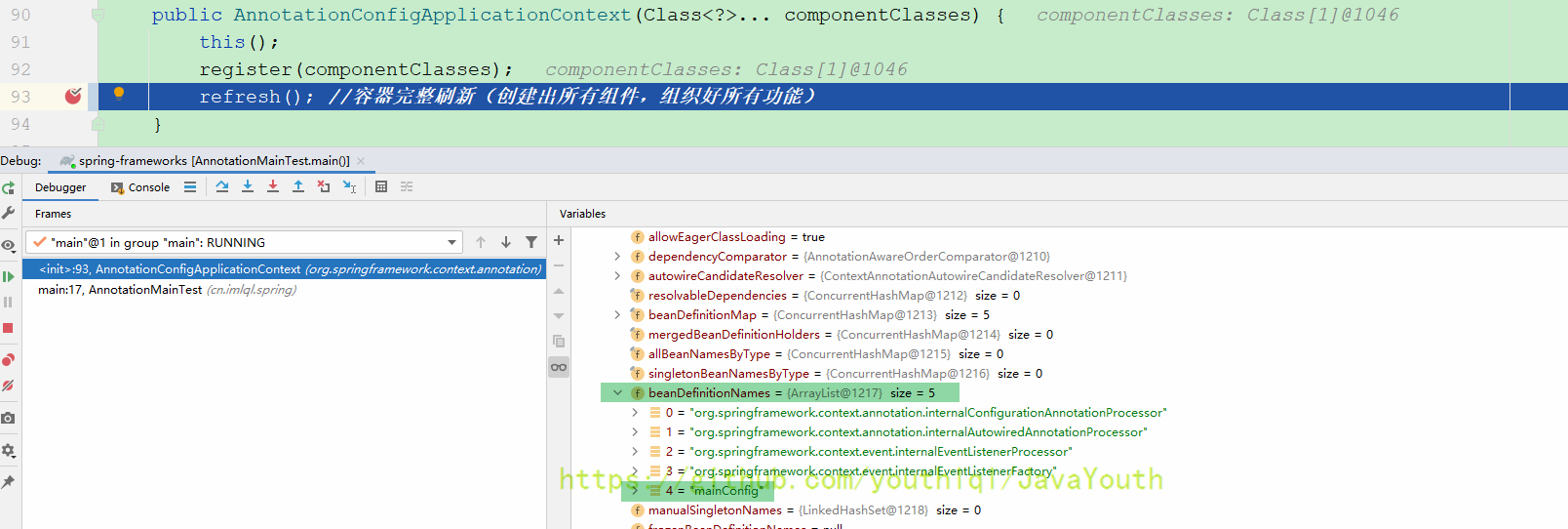
- 接下来就是想办法让主配置类里的配置生效
- 目前Spring就靠上面的4个后置处理器和一个主配置类白手起家了,开始我们后面最重要的refresh()容器刷新流程了
AbstractApplicationContext#refresh()开始容器刷新
@Override //容器刷新的十二大步。模板模式
public void refresh() throws BeansException, IllegalStateException {
synchronized (this.startupShutdownMonitor) {
//容器启动过程状态的封装类
StartupStep contextRefresh = this.applicationStartup.start("spring.context.refresh");
//准备上下文环境 Prepare this context for refreshing.
prepareRefresh();
// Tell the subclass to refresh the internal bean factory.
// 工厂创建:BeanFactory第一次开始创建的时候,有xml解析逻辑。注解版这一步什么都没做,直接返回this()环节早就new好的工厂
ConfigurableListableBeanFactory beanFactory = obtainFreshBeanFactory();
//给容器中注册了环境信息作为单实例Bean方便后续自动装配;放了一些后置处理器处理(监听、xxAware功能) Prepare thebean factory for use in this context.
prepareBeanFactory(beanFactory);
try {
//留给子类的模板方法,允许子类继续对工厂执行一些处理; Allows post-processing of the bean factory in context subclasses.
postProcessBeanFactory(beanFactory);
StartupStep beanPostProcess = this.applicationStartup.start("spring.context.beans.post-process");
//【核心】工厂增强:执行所有的BeanFactory后置增强器;利用BeanFactory后置增强器对工厂进行修改或者增强,配置类会在这里进行解析。 Invoke factory processors registered as beans in the context.
invokeBeanFactoryPostProcessors(beanFactory);
//【核心】注册所有的Bean的后置处理器 Register bean processors that intercept bean creation.
registerBeanPostProcessors(beanFactory);
beanPostProcess.end();
//初始化国际化功能 Initialize message source for this context.
initMessageSource();
//初始化事件多播功能(事件派发) Initialize event multicaster for this context.
initApplicationEventMulticaster();
// Initialize other special beans in specific context subclasses.
onRefresh();
//注册监听器,从容器中获取所有的ApplicationListener; Check for listener beans and register them.
registerListeners();
// Instantiate all remaining (non-lazy-init) singletons.
//【大核心】bean创建;完成 BeanFactory 初始化。(工厂里面所有的组件都好了)
finishBeanFactoryInitialization(beanFactory);
//发布事件 Last step: publish corresponding event.
finishRefresh();
}
catch (BeansException ex) {
if (logger.isWarnEnabled()) {
logger.warn("Exception encountered during context initialization - " +
"cancelling refresh attempt: " + ex);
}
// Destroy already created singletons to avoid dangling resources.
destroyBeans();
// Reset 'active' flag.
cancelRefresh(ex);
// Propagate exception to caller.
throw ex;
}
finally {
// Reset common introspection caches in Spring's core, since we
// might not ever need metadata for singleton beans anymore...
resetCommonCaches();
contextRefresh.end();
}
}
}
prepareRefresh()准备上下文环境
protected void prepareRefresh() {
// Switch to active.
this.startupDate = System.currentTimeMillis();
this.closed.set(false);
this.active.set(true);
if (logger.isDebugEnabled()) {
if (logger.isTraceEnabled()) {
logger.trace("Refreshing " + this);
}
else {
logger.debug("Refreshing " + getDisplayName());
}
}
//其他子容器自行实现(比如:WebApplicationContext) Initialize any placeholder property sources in the context environment.
initPropertySources();
//准备环境变量信息 Validate that all properties marked as required are resolvable:
// see ConfigurablePropertyResolver#setRequiredProperties
getEnvironment().validateRequiredProperties();
// 存储子容器早期运行的一些监听器; Store pre-refresh ApplicationListeners...
if (this.earlyApplicationListeners == null) {
this.earlyApplicationListeners = new LinkedHashSet<>(this.applicationListeners);
}
else {
// Reset local application listeners to pre-refresh state.
this.applicationListeners.clear();
this.applicationListeners.addAll(this.earlyApplicationListeners);
}
//早期的一些事件存储到这里 Allow for the collection of early ApplicationEvents,
// to be published once the multicaster is available...
this.earlyApplicationEvents = new LinkedHashSet<>();
}
initPropertySources()
protected void initPropertySources() {
// For subclasses: do nothing by default. 自行在此处加载一些自己感兴趣的信息。【WebApplicationContextUtils.initServletPropertySources】
// web-ioc容器启动的时候一般在此加载当前应用的上下文信息(ApplicationContext)
}
prepareBeanFactory()给BeanFactory准备一些核心组件
protected void prepareBeanFactory(ConfigurableListableBeanFactory beanFactory) {
// Tell the internal bean factory to use the context's class loader etc.
beanFactory.setBeanClassLoader(getClassLoader());
if (!shouldIgnoreSpel) { //解释器模式 ,解析el表达式
beanFactory.setBeanExpressionResolver(new StandardBeanExpressionResolver(beanFactory.getBeanClassLoader()));
}
beanFactory.addPropertyEditorRegistrar(new ResourceEditorRegistrar(this, getEnvironment()));
// Configure the bean factory with context callbacks.
beanFactory.addBeanPostProcessor(new ApplicationContextAwareProcessor(this)); //准备一个处理Aware接口功能的后置处理器
beanFactory.ignoreDependencyInterface(EnvironmentAware.class); //告诉Spring先别管这些接口
beanFactory.ignoreDependencyInterface(EmbeddedValueResolverAware.class);
beanFactory.ignoreDependencyInterface(ResourceLoaderAware.class);
beanFactory.ignoreDependencyInterface(ApplicationEventPublisherAware.class);
beanFactory.ignoreDependencyInterface(MessageSourceAware.class);
beanFactory.ignoreDependencyInterface(ApplicationContextAware.class);
beanFactory.ignoreDependencyInterface(ApplicationStartupAware.class);
/*
1.注册可以解析到的依赖,直接保存到容器的resolvableDependencies池里
2.意思就是在我们自定义的类中,我们可以直接用@Autowired注解注入下面4个东西,并直接使用
*/
beanFactory.registerResolvableDependency(BeanFactory.class, beanFactory);
beanFactory.registerResolvableDependency(ResourceLoader.class, this);
beanFactory.registerResolvableDependency(ApplicationEventPublisher.class, this);
beanFactory.registerResolvableDependency(ApplicationContext.class, this);
// 注册应用监听器的探测器,用来探测应用中有哪些监听器。这也是一个后置处理器
beanFactory.addBeanPostProcessor(new ApplicationListenerDetector(this));
// Detect a LoadTimeWeaver and prepare for weaving, if found.
if (!NativeDetector.inNativeImage() && beanFactory.containsBean(LOAD_TIME_WEAVER_BEAN_NAME)) {
beanFactory.addBeanPostProcessor(new LoadTimeWeaverAwareProcessor(beanFactory));
// Set a temporary ClassLoader for type matching.
beanFactory.setTempClassLoader(new ContextTypeMatchClassLoader(beanFactory.getBeanClassLoader()));
}
//注册默认组件: Register default environment beans.
if (!beanFactory.containsLocalBean(ENVIRONMENT_BEAN_NAME)) {
beanFactory.registerSingleton(ENVIRONMENT_BEAN_NAME, getEnvironment());
}
if (!beanFactory.containsLocalBean(SYSTEM_PROPERTIES_BEAN_NAME)) {
beanFactory.registerSingleton(SYSTEM_PROPERTIES_BEAN_NAME, getEnvironment().getSystemProperties());
}
if (!beanFactory.containsLocalBean(SYSTEM_ENVIRONMENT_BEAN_NAME)) {
beanFactory.registerSingleton(SYSTEM_ENVIRONMENT_BEAN_NAME, getEnvironment().getSystemEnvironment());
}
if (!beanFactory.containsLocalBean(APPLICATION_STARTUP_BEAN_NAME)) {
beanFactory.registerSingleton(APPLICATION_STARTUP_BEAN_NAME, getApplicationStartup());
}
}
String ENVIRONMENT_BEAN_NAME = "environment";
String SYSTEM_PROPERTIES_BEAN_NAME = "systemProperties";
String SYSTEM_ENVIRONMENT_BEAN_NAME = "systemEnvironment";
/**
* Name of the {@link ApplicationStartup} bean in the factory.
* @since 5.3
*/
String APPLICATION_STARTUP_BEAN_NAME = "applicationStartup";
postProcessBeanFactory()留给子类的模板方法
这里是一个空方法,主要是留给子类实现,比如Web里的
protected void postProcessBeanFactory(ConfigurableListableBeanFactory beanFactory) {
}

invokeBeanFactoryPostProcessors()工厂增强【核心】
protected void invokeBeanFactoryPostProcessors(ConfigurableListableBeanFactory beanFactory) {
PostProcessorRegistrationDelegate.invokeBeanFactoryPostProcessors(beanFactory, getBeanFactoryPostProcessors()); //执行所有的工厂增强器
//上面的类叫:后置处理器的注册代理(门面模式-装饰模式)
// Detect a LoadTimeWeaver and prepare for weaving, if found in the meantime
// (e.g. through an @Bean method registered by ConfigurationClassPostProcessor)
if (!NativeDetector.inNativeImage() && beanFactory.getTempClassLoader() == null && beanFactory.containsBean(LOAD_TIME_WEAVER_BEAN_NAME)) {
beanFactory.addBeanPostProcessor(new LoadTimeWeaverAwareProcessor(beanFactory));
beanFactory.setTempClassLoader(new ContextTypeMatchClassLoader(beanFactory.getBeanClassLoader()));
}
}
这一步有个很关键的后置处理器
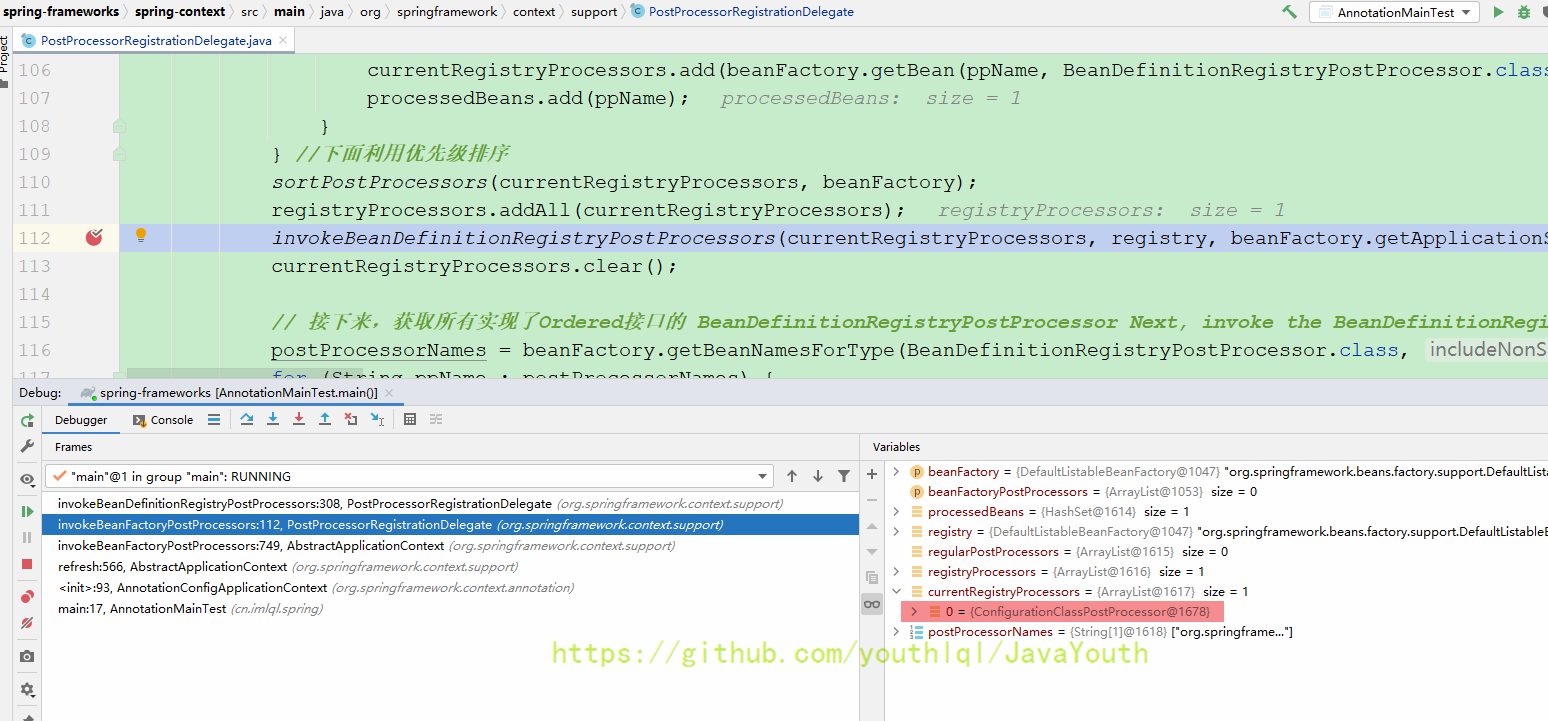
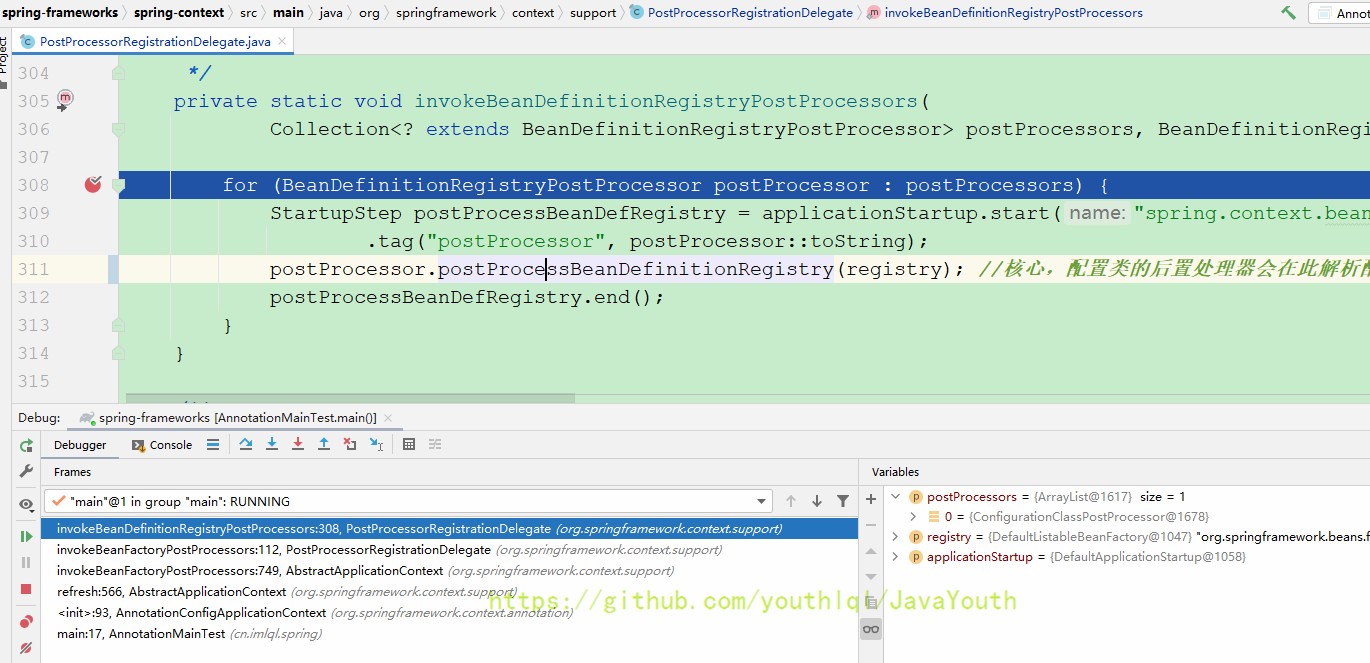
ConfigurationClassPostProcessor#postProcessBeanDefinitionRegistry()开始解析@Configuration标注的所有配置类相关信息,并生成Bean
AnnotationConfigApplicationContext#register()这里解析的是主配置类
@Override //把配置类中所有bean的定义信息导入进来。
public void postProcessBeanDefinitionRegistry(BeanDefinitionRegistry registry) {
int registryId = System.identityHashCode(registry);
if (this.registriesPostProcessed.contains(registryId)) {
throw new IllegalStateException(
"postProcessBeanDefinitionRegistry already called on this post-processor against " + registry);
}
if (this.factoriesPostProcessed.contains(registryId)) {
throw new IllegalStateException(
"postProcessBeanFactory already called on this post-processor against " + registry);
}
this.registriesPostProcessed.add(registryId);
processConfigBeanDefinitions(registry); //处理配置的BeanDefinition信息
}
public void processConfigBeanDefinitions(BeanDefinitionRegistry registry) {
List<BeanDefinitionHolder> configCandidates = new ArrayList<>();
String[] candidateNames = registry.getBeanDefinitionNames(); //拿到工厂所有的bean定义信息
for (String beanName : candidateNames) {
BeanDefinition beanDef = registry.getBeanDefinition(beanName);
if (beanDef.getAttribute(ConfigurationClassUtils.CONFIGURATION_CLASS_ATTRIBUTE) != null) {
if (logger.isDebugEnabled()) {
logger.debug("Bean definition has already been processed as a configuration class: " + beanDef);
}
}
else if (ConfigurationClassUtils.checkConfigurationClassCandidate(beanDef, this.metadataReaderFactory)) {
configCandidates.add(new BeanDefinitionHolder(beanDef, beanName)); //将配置类加到候选集合里面,等待处理
}
}
// Return immediately if no @Configuration classes were found
if (configCandidates.isEmpty()) {
return;
}
// 对所有的配置类进行排序,Sort by previously determined @Order value, if applicable
configCandidates.sort((bd1, bd2) -> {
int i1 = ConfigurationClassUtils.getOrder(bd1.getBeanDefinition());
int i2 = ConfigurationClassUtils.getOrder(bd2.getBeanDefinition());
return Integer.compare(i1, i2);
});
// Detect any custom bean name generation strategy supplied through the enclosing application context
SingletonBeanRegistry sbr = null;
if (registry instanceof SingletonBeanRegistry) {
sbr = (SingletonBeanRegistry) registry;
if (!this.localBeanNameGeneratorSet) {
BeanNameGenerator generator = (BeanNameGenerator) sbr.getSingleton(
AnnotationConfigUtils.CONFIGURATION_BEAN_NAME_GENERATOR); //getBean--getSingleton,获取创建一个internalConfigurationBeanNameGenerator来用来生成配置类的名字
if (generator != null) {
this.componentScanBeanNameGenerator = generator;
this.importBeanNameGenerator = generator;
}
}
}
if (this.environment == null) {
this.environment = new StandardEnvironment();
}
//由ConfigurationClassParser解析每一个配置类 Parse each @Configuration class
ConfigurationClassParser parser = new ConfigurationClassParser(
this.metadataReaderFactory, this.problemReporter, this.environment,
this.resourceLoader, this.componentScanBeanNameGenerator, registry);
Set<BeanDefinitionHolder> candidates = new LinkedHashSet<>(configCandidates);
Set<ConfigurationClass> alreadyParsed = new HashSet<>(configCandidates.size());
do {
StartupStep processConfig = this.applicationStartup.start("spring.context.config-classes.parse");
parser.parse(candidates); //解析配置类;所有需要扫描进来的组件的BeanDefinition信息都已经完成
parser.validate();
Set<ConfigurationClass> configClasses = new LinkedHashSet<>(parser.getConfigurationClasses());
configClasses.removeAll(alreadyParsed);
//每一个组件都可以当配置类,@Import之类的都能进行处理
// Read the model and create bean definitions based on its content
if (this.reader == null) {
this.reader = new ConfigurationClassBeanDefinitionReader(
registry, this.sourceExtractor, this.resourceLoader, this.environment,
this.importBeanNameGenerator, parser.getImportRegistry());
}
this.reader.loadBeanDefinitions(configClasses);
alreadyParsed.addAll(configClasses);
processConfig.tag("classCount", () -> String.valueOf(configClasses.size())).end();
candidates.clear();
if (registry.getBeanDefinitionCount() > candidateNames.length) {
String[] newCandidateNames = registry.getBeanDefinitionNames();
Set<String> oldCandidateNames = new HashSet<>(Arrays.asList(candidateNames));
Set<String> alreadyParsedClasses = new HashSet<>();
for (ConfigurationClass configurationClass : alreadyParsed) {
alreadyParsedClasses.add(configurationClass.getMetadata().getClassName());
}
for (String candidateName : newCandidateNames) {
if (!oldCandidateNames.contains(candidateName)) {
BeanDefinition bd = registry.getBeanDefinition(candidateName);
if (ConfigurationClassUtils.checkConfigurationClassCandidate(bd, this.metadataReaderFactory) &&
!alreadyParsedClasses.contains(bd.getBeanClassName())) {
candidates.add(new BeanDefinitionHolder(bd, candidateName));
}
}
}
candidateNames = newCandidateNames;
}
}
while (!candidates.isEmpty());
// Register the ImportRegistry as a bean in order to support ImportAware @Configuration classes
if (sbr != null && !sbr.containsSingleton(IMPORT_REGISTRY_BEAN_NAME)) {
sbr.registerSingleton(IMPORT_REGISTRY_BEAN_NAME, parser.getImportRegistry());
}
if (this.metadataReaderFactory instanceof CachingMetadataReaderFactory) {
// Clear cache in externally provided MetadataReaderFactory; this is a no-op
// for a shared cache since it'll be cleared by the ApplicationContext.
((CachingMetadataReaderFactory) this.metadataReaderFactory).clearCache();
}
}
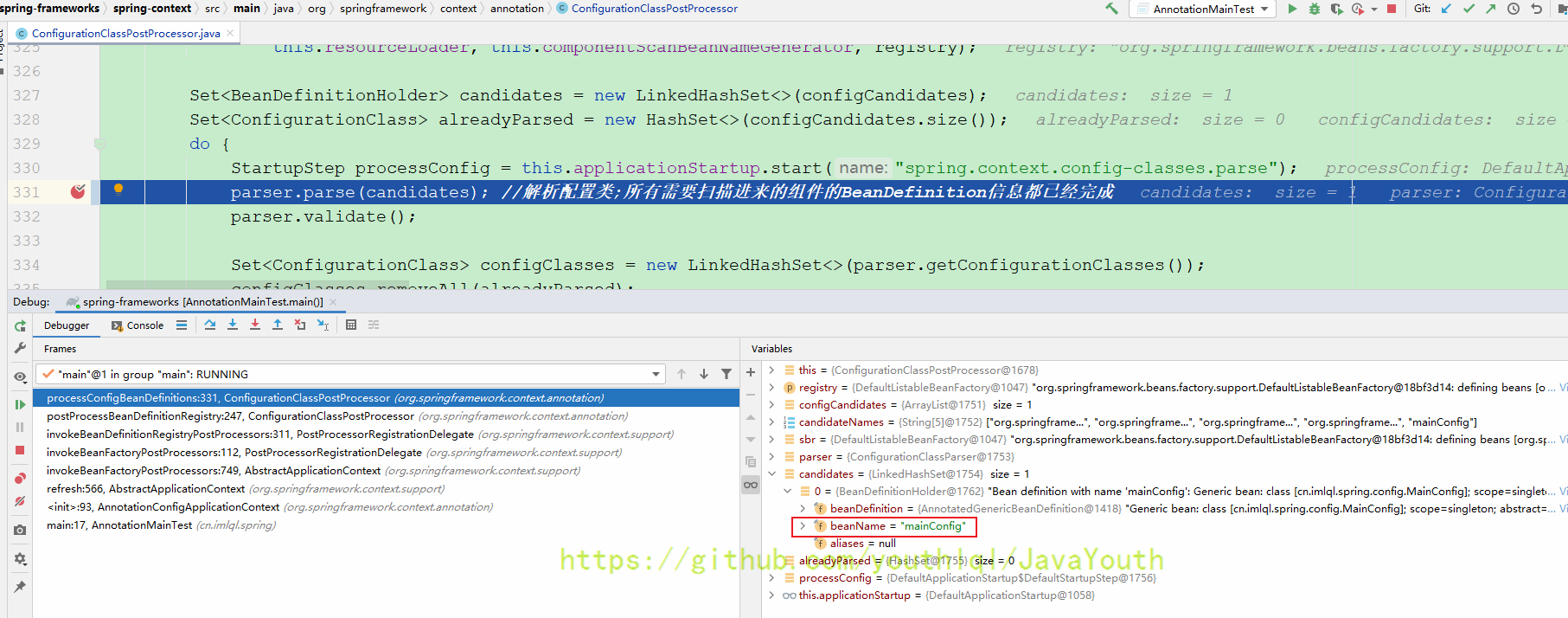
ConfigurationClassParser#parse()
public void parse(Set<BeanDefinitionHolder> configCandidates) {
for (BeanDefinitionHolder holder : configCandidates) {
BeanDefinition bd = holder.getBeanDefinition();
try {
if (bd instanceof AnnotatedBeanDefinition) {
parse(((AnnotatedBeanDefinition) bd).getMetadata(), holder.getBeanName());
}
else if (bd instanceof AbstractBeanDefinition && ((AbstractBeanDefinition) bd).hasBeanClass()) {
parse(((AbstractBeanDefinition) bd).getBeanClass(), holder.getBeanName());
}
else {
parse(bd.getBeanClassName(), holder.getBeanName());
}
}
catch (BeanDefinitionStoreException ex) {
throw ex;
}
catch (Throwable ex) {
throw new BeanDefinitionStoreException(
"Failed to parse configuration class [" + bd.getBeanClassName() + "]", ex);
}
}
this.deferredImportSelectorHandler.process();
}
//解析配置类
protected final void parse(AnnotationMetadata metadata, String beanName) throws IOException {
processConfigurationClass(new ConfigurationClass(metadata, beanName), DEFAULT_EXCLUSION_FILTER);
}
protected void processConfigurationClass(ConfigurationClass configClass, Predicate<String> filter) throws IOException {
if (this.conditionEvaluator.shouldSkip(configClass.getMetadata(), ConfigurationPhase.PARSE_CONFIGURATION)) {
return;
}
//Spring底层大量使用缓存来保证框架速度
ConfigurationClass existingClass = this.configurationClasses.get(configClass);
if (existingClass != null) {
if (configClass.isImported()) {
if (existingClass.isImported()) {
existingClass.mergeImportedBy(configClass);
}
// Otherwise ignore new imported config class; existing non-imported class overrides it.
return;
}
else {
// Explicit bean definition found, probably replacing an import.
// Let's remove the old one and go with the new one.
this.configurationClasses.remove(configClass);
this.knownSuperclasses.values().removeIf(configClass::equals);
}
}
// Recursively process the configuration class and its superclass hierarchy.
SourceClass sourceClass = asSourceClass(configClass, filter);
do { //解析配置类里面的所有注解,
sourceClass = doProcessConfigurationClass(configClass, sourceClass, filter);
}
while (sourceClass != null);
//只要这个配置类解析过,就放在已经解析好的集合中防止重复解析
this.configurationClasses.put(configClass, configClass);
}
ConfigurationClassParser#doProcessConfigurationClass()解析配置类中诸如@ComponentScan,@Import,@Bean等注解
private final Environment environment;
private final BeanDefinitionRegistry registry;
private final ComponentScanAnnotationParser componentScanParser;
private final Map<ConfigurationClass, ConfigurationClass> configurationClasses = new LinkedHashMap<>();
private final Map<String, ConfigurationClass> knownSuperclasses = new HashMap<>();
protected final SourceClass doProcessConfigurationClass(
ConfigurationClass configClass, SourceClass sourceClass, Predicate<String> filter)
throws IOException {
if (configClass.getMetadata().isAnnotated(Component.class.getName())) {
// Recursively process any member (nested) classes first
processMemberClasses(configClass, sourceClass, filter);
}
// Process any @PropertySource annotations
for (AnnotationAttributes propertySource : AnnotationConfigUtils.attributesForRepeatable(
sourceClass.getMetadata(), PropertySources.class,
org.springframework.context.annotation.PropertySource.class)) {
if (this.environment instanceof ConfigurableEnvironment) {
processPropertySource(propertySource);
}
else {
logger.info("Ignoring @PropertySource annotation on [" + sourceClass.getMetadata().getClassName() +
"]. Reason: Environment must implement ConfigurableEnvironment");
}
}
// Process any @ComponentScan annotations
Set<AnnotationAttributes> componentScans = AnnotationConfigUtils.attributesForRepeatable(
sourceClass.getMetadata(), ComponentScans.class, ComponentScan.class);
if (!componentScans.isEmpty() &&
!this.conditionEvaluator.shouldSkip(sourceClass.getMetadata(), ConfigurationPhase.REGISTER_BEAN)) {
for (AnnotationAttributes componentScan : componentScans) {
//使用Scanner把ComponentScan指定的包下的所有组件都扫描进来 The config class is annotated with @ComponentScan -> perform the scan immediately
Set<BeanDefinitionHolder> scannedBeanDefinitions =
this.componentScanParser.parse(componentScan, sourceClass.getMetadata().getClassName());
// Check the set of scanned definitions for any further config classes and parse recursively if needed
for (BeanDefinitionHolder holder : scannedBeanDefinitions) {
BeanDefinition bdCand = holder.getBeanDefinition().getOriginatingBeanDefinition();
if (bdCand == null) {
bdCand = holder.getBeanDefinition();
}
if (ConfigurationClassUtils.checkConfigurationClassCandidate(bdCand, this.metadataReaderFactory)) {
parse(bdCand.getBeanClassName(), holder.getBeanName());
}
}
}
}
//处理@Import注解的地方【AOP就是利用这个地方导入一个后置处理器的】 Process any @Import annotations
processImports(configClass, sourceClass, getImports(sourceClass), filter, true);
//处理@ImportResource Process any @ImportResource annotations
AnnotationAttributes importResource =
AnnotationConfigUtils.attributesFor(sourceClass.getMetadata(), ImportResource.class);
if (importResource != null) {
String[] resources = importResource.getStringArray("locations");
Class<? extends BeanDefinitionReader> readerClass = importResource.getClass("reader");
for (String resource : resources) {
String resolvedResource = this.environment.resolveRequiredPlaceholders(resource);
configClass.addImportedResource(resolvedResource, readerClass);
}
}
//处理@Bean Process individual @Bean methods
Set<MethodMetadata> beanMethods = retrieveBeanMethodMetadata(sourceClass);
for (MethodMetadata methodMetadata : beanMethods) {
configClass.addBeanMethod(new BeanMethod(methodMetadata, configClass));
}
// Process default methods on interfaces
processInterfaces(configClass, sourceClass);
// Process superclass, if any
if (sourceClass.getMetadata().hasSuperClass()) {
String superclass = sourceClass.getMetadata().getSuperClassName();
if (superclass != null && !superclass.startsWith("java") &&
!this.knownSuperclasses.containsKey(superclass)) {
this.knownSuperclasses.put(superclass, configClass);
// Superclass found, return its annotation metadata and recurse
return sourceClass.getSuperClass();
}
}
// No superclass -> processing is complete
return null;
}
ComponentScanAnnotationParser#parse()具体如何解析@ComponentScan注解。这里也是@Component注解生效的地方
public Set<BeanDefinitionHolder> parse(AnnotationAttributes componentScan, final String declaringClass) {
ClassPathBeanDefinitionScanner scanner = new ClassPathBeanDefinitionScanner(this.registry,
componentScan.getBoolean("useDefaultFilters"), this.environment, this.resourceLoader);
// ...省略不重要
return scanner.doScan(StringUtils.toStringArray(basePackages)); //扫描器进行扫描
}
ClassPathBeanDefinitionScanner#doScan()
public class ClassPathBeanDefinitionScanner extends ClassPathScanningCandidateComponentProvider{
//...
protected Set<BeanDefinitionHolder> doScan(String... basePackages) {
Assert.notEmpty(basePackages, "At least one base package must be specified");
Set<BeanDefinitionHolder> beanDefinitions = new LinkedHashSet<>();
for (String basePackage : basePackages) {
Set<BeanDefinition> candidates = findCandidateComponents(basePackage); //找到候选组件(我们需要扫描进来的组件),这里是调用父类的方法
for (BeanDefinition candidate : candidates) {
ScopeMetadata scopeMetadata = this.scopeMetadataResolver.resolveScopeMetadata(candidate);
candidate.setScope(scopeMetadata.getScopeName());
String beanName = this.beanNameGenerator.generateBeanName(candidate, this.registry);
if (candidate instanceof AbstractBeanDefinition) {
postProcessBeanDefinition((AbstractBeanDefinition) candidate, beanName);
}
if (candidate instanceof AnnotatedBeanDefinition) {
AnnotationConfigUtils.processCommonDefinitionAnnotations((AnnotatedBeanDefinition) candidate);
}
if (checkCandidate(beanName, candidate)) {
BeanDefinitionHolder definitionHolder = new BeanDefinitionHolder(candidate, beanName);
definitionHolder =
AnnotationConfigUtils.applyScopedProxyMode(scopeMetadata, definitionHolder, this.registry);
beanDefinitions.add(definitionHolder);
registerBeanDefinition(definitionHolder, this.registry);
}
}
}
return beanDefinitions;
}
// ...
}
ClassPathScanningCandidateComponentProvider#findCandidateComponents()
public Set<BeanDefinition> findCandidateComponents(String basePackage) {
if (this.componentsIndex != null && indexSupportsIncludeFilters()) {
return addCandidateComponentsFromIndex(this.componentsIndex, basePackage);
}
else {
return scanCandidateComponents(basePackage); //扫描所有组件
}
}
private Set<BeanDefinition> scanCandidateComponents(String basePackage) {
Set<BeanDefinition> candidates = new LinkedHashSet<>();
try {
String packageSearchPath = ResourcePatternResolver.CLASSPATH_ALL_URL_PREFIX +
resolveBasePackage(basePackage) + '/' + this.resourcePattern;
Resource[] resources = getResourcePatternResolver().getResources(packageSearchPath);
boolean traceEnabled = logger.isTraceEnabled();
boolean debugEnabled = logger.isDebugEnabled();
for (Resource resource : resources) {
if (traceEnabled) {
logger.trace("Scanning " + resource);
}
if (resource.isReadable()) {
try { //生成每一个资源的元数据信息
MetadataReader metadataReader = getMetadataReaderFactory().getMetadataReader(resource);
if (isCandidateComponent(metadataReader)) { //如果当前类在扫描范围
ScannedGenericBeanDefinition sbd = new ScannedGenericBeanDefinition(metadataReader);
sbd.setSource(resource);
if (isCandidateComponent(sbd)) {
if (debugEnabled) {
logger.debug("Identified candidate component class: " + resource);
}
candidates.add(sbd);
}
else {
if (debugEnabled) {
logger.debug("Ignored because not a concrete top-level class: " + resource);
}
}
}
else {
if (traceEnabled) {
logger.trace("Ignored because not matching any filter: " + resource);
}
}
}
catch (Throwable ex) {
throw new BeanDefinitionStoreException(
"Failed to read candidate component class: " + resource, ex);
}
}
else {
if (traceEnabled) {
logger.trace("Ignored because not readable: " + resource);
}
}
}
}
catch (IOException ex) {
throw new BeanDefinitionStoreException("I/O failure during classpath scanning", ex);
}
return candidates;
}
拿到所有类(资源),不管你有没有标@Component注解。然后挨个遍历每一个资源是不是候选的组件(根据前面准备的一些条件,在这里进行判断)
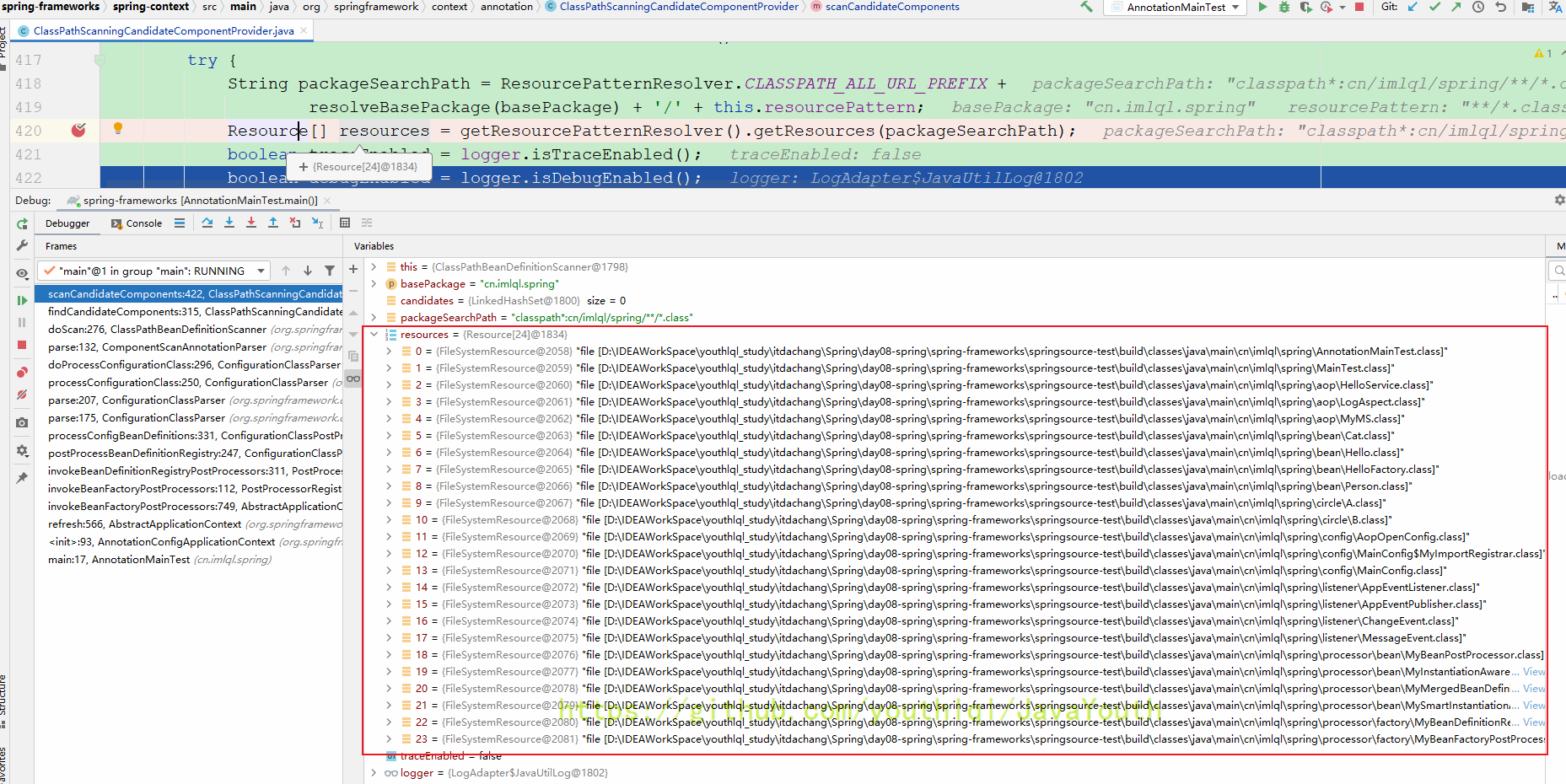
最后我们看一下执行完之后的BeanDefinition信息

registerBeanPostProcessors()注册所有的Bean后置处理器
前面讲过
protected void registerBeanPostProcessors(ConfigurableListableBeanFactory beanFactory) {
PostProcessorRegistrationDelegate.registerBeanPostProcessors(beanFactory, this);
}
PostProcessorRegistrationDelegate#registerBeanPostProcessors()
public static void registerBeanPostProcessors(
ConfigurableListableBeanFactory beanFactory, AbstractApplicationContext applicationContext) {
// WARNING: Although it may appear that the body of this method can be easily
// refactored to avoid the use of multiple loops and multiple lists, the use
// of multiple lists and multiple passes over the names of processors is
// intentional. We must ensure that we honor the contracts for PriorityOrdered
// and Ordered processors. Specifically, we must NOT cause processors to be
// instantiated (via getBean() invocations) or registered in the ApplicationContext
// in the wrong order.
//
// Before submitting a pull request (PR) to change this method, please review the
// list of all declined PRs involving changes to PostProcessorRegistrationDelegate
// to ensure that your proposal does not result in a breaking change:
// https://github.com/spring-projects/spring-framework/issues?q=PostProcessorRegistrationDelegate+is%3Aclosed+label%3A%22status%3A+declined%22
//获取到容器中所有的 BeanPostProcessor; Bean的后置处理器
String[] postProcessorNames = beanFactory.getBeanNamesForType(BeanPostProcessor.class, true, false);
// Register BeanPostProcessorChecker that logs an info message when
// a bean is created during BeanPostProcessor instantiation, i.e. when
// a bean is not eligible for getting processed by all BeanPostProcessors.
int beanProcessorTargetCount = beanFactory.getBeanPostProcessorCount() + 1 + postProcessorNames.length;
beanFactory.addBeanPostProcessor(new BeanPostProcessorChecker(beanFactory, beanProcessorTargetCount));
// Separate between BeanPostProcessors that implement PriorityOrdered,
// Ordered, and the rest.
List<BeanPostProcessor> priorityOrderedPostProcessors = new ArrayList<>();
List<BeanPostProcessor> internalPostProcessors = new ArrayList<>();
List<String> orderedPostProcessorNames = new ArrayList<>();
List<String> nonOrderedPostProcessorNames = new ArrayList<>();
for (String ppName : postProcessorNames) {
if (beanFactory.isTypeMatch(ppName, PriorityOrdered.class)) { //获取所有实现了 PriorityOrdered 的 BeanPostProcessor
BeanPostProcessor pp = beanFactory.getBean(ppName, BeanPostProcessor.class);
priorityOrderedPostProcessors.add(pp);
if (pp instanceof MergedBeanDefinitionPostProcessor) {
internalPostProcessors.add(pp);
}
}
else if (beanFactory.isTypeMatch(ppName, Ordered.class)) {
orderedPostProcessorNames.add(ppName);
}
else {
nonOrderedPostProcessorNames.add(ppName);
}
}
//首先,注册所有的实现了 PriorityOrdered 的 BeanPostProcessor ; First, register the BeanPostProcessors that implement PriorityOrdered.
sortPostProcessors(priorityOrderedPostProcessors, beanFactory);
registerBeanPostProcessors(beanFactory, priorityOrderedPostProcessors);
//接下来,注册所有的实现了 Ordered 的 BeanPostProcessor Next, register the BeanPostProcessors that implement Ordered.
List<BeanPostProcessor> orderedPostProcessors = new ArrayList<>(orderedPostProcessorNames.size());
for (String ppName : orderedPostProcessorNames) {
BeanPostProcessor pp = beanFactory.getBean(ppName, BeanPostProcessor.class);
orderedPostProcessors.add(pp);
if (pp instanceof MergedBeanDefinitionPostProcessor) {
internalPostProcessors.add(pp);
}
}
sortPostProcessors(orderedPostProcessors, beanFactory);
registerBeanPostProcessors(beanFactory, orderedPostProcessors);
// 最后,注册所有普通的 BeanPostProcessor ;Now, register all regular BeanPostProcessors.
List<BeanPostProcessor> nonOrderedPostProcessors = new ArrayList<>(nonOrderedPostProcessorNames.size());
for (String ppName : nonOrderedPostProcessorNames) {
BeanPostProcessor pp = beanFactory.getBean(ppName, BeanPostProcessor.class); //从容器中获取这个组件
nonOrderedPostProcessors.add(pp);
if (pp instanceof MergedBeanDefinitionPostProcessor) {
internalPostProcessors.add(pp);
}
}
registerBeanPostProcessors(beanFactory, nonOrderedPostProcessors);
//最后,重新注册所有internal的BeanPostProcessors Finally, re-register all internal BeanPostProcessors.
sortPostProcessors(internalPostProcessors, beanFactory);
registerBeanPostProcessors(beanFactory, internalPostProcessors);
// 重新注册一下这个后置处理器 Re-register post-processor for detecting inner beans as ApplicationListeners,
// 把他放到后置处理器的最后一位; moving it to the end of the processor chain (for picking up proxies etc).
beanFactory.addBeanPostProcessor(new ApplicationListenerDetector(applicationContext));
}
initMessageSource()
初始化国际化功能
- 看容器中是否有MessageSource的定义信息
- 如果没有就注册一个默认的
- 把国际化组件(MessageSource) 放到单例池中
initApplicationEventMulticaster()
初始化事件多播功能(事件派发)
- 看容器中是否有applicationEventMulticaster的定义信息,按照id找
- 如果没有就注册一个默认的
- 把事件多播器组件(ApplicationEventMulticaster) 放到单例池中
onRefresh()模板方法留给子类继续增强处理
留给子类继续增强处理,模板模式。
registerListeners()
注册监听器,从容器中获取所有的ApplicationListener
/** 多播器和监听器是观察者模式(里面包含了所有的监听器)
* Add beans that implement ApplicationListener as listeners.
* Doesn't affect other listeners, which can be added without being beans.
*/
protected void registerListeners() {
//把所有监听器保存到多播器的集合中 Register statically specified listeners first.
for (ApplicationListener<?> listener : getApplicationListeners()) {
getApplicationEventMulticaster().addApplicationListener(listener);
}
// Do not initialize FactoryBeans here: We need to leave all regular beans
// uninitialized to let post-processors apply to them! 获取ApplicationListener在ioc容器中注册的bean的名字
String[] listenerBeanNames = getBeanNamesForType(ApplicationListener.class, true, false);
for (String listenerBeanName : listenerBeanNames) {
getApplicationEventMulticaster().addApplicationListenerBean(listenerBeanName); //获取所有的容器中的监听器,并保存他们的名字
}
//派发之前攒的一些早期事件 Publish early application events now that we finally have a multicaster...
Set<ApplicationEvent> earlyEventsToProcess = this.earlyApplicationEvents;
this.earlyApplicationEvents = null;
if (!CollectionUtils.isEmpty(earlyEventsToProcess)) {
for (ApplicationEvent earlyEvent : earlyEventsToProcess) {
getApplicationEventMulticaster().multicastEvent(earlyEvent);
}
}
}
监听器也是一个重点,后面细讲
finishBeanFactoryInitialization()正式创建所有普通Bean
前面Bean的初始化流程讲的很仔细了
- 主要就是遍历循环所有BeanDefinition里的BeanName,挨个创建Bean对象。注意BeanPostProcessor这些不算普通Bean,在registerBeanPostProcessors(),invokeBeanFactoryPostProcessors()已经创建完了,因为在普通Bean创建的过程中,后置处理器可能需要参与进来,所以需要比普通Bean提前创建好
- 最后执行SmartInitializingSingleton.afterSingletonsInstantiated后初始化
finishRefresh()主要是发送容器刷新完成的事件
最后进行一些清理和事件发送等
protected void finishRefresh() {
// Clear context-level resource caches (such as ASM metadata from scanning).
clearResourceCaches();
// Initialize lifecycle processor for this context.
initLifecycleProcessor();
//告诉LifecycleProcessor容器onRefresh Propagate refresh to lifecycle processor first.
getLifecycleProcessor().onRefresh();
//发布事件 Publish the final event.
publishEvent(new ContextRefreshedEvent(this));
//jconsole(暴露MBean端点信息) Participate in LiveBeansView MBean, if active.
if (!NativeDetector.inNativeImage()) {
LiveBeansView.registerApplicationContext(this);
}
}
自此over
补充:循环引用解决方案
单开一节,讲一下之前一直忽略的这个。其实很简单的一个东西,被网上搞的很难一样。
测试类
A
@Component
public class A {
private B b;
public A() {
System.out.println("A...构造....");
}
@Autowired
public void setB(B b) {
this.b = b;
}
}
B
@Component
public class B {
private A a;
public B() {
System.out.println("B...构造....");
}
@Autowired
public void setA(A a) {
this.a = a;
}
}
这就是循环引用的场景,这种写法由于Spring内部获取Bean都是通过getBean方法来获取,就造成了下面的死循环。我们来看看Spring是怎么解决的。
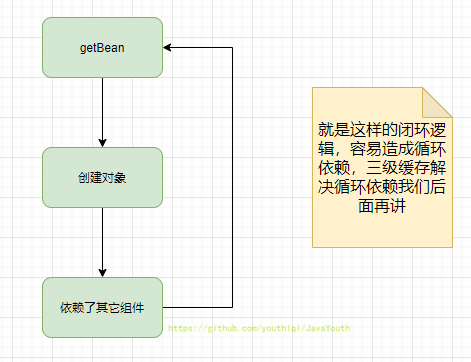
核心代码
AbstractBeanFactory
protected <T> T doGetBean(
String name, @Nullable Class<T> requiredType, @Nullable Object[] args, boolean typeCheckOnly)
throws BeansException {
String beanName = transformedBeanName(name); //转换Bean名字
Object beanInstance;
// 先检查单实例bean的缓存 Eagerly check singleton cache for manually registered singletons.
// ☆☆☆ pos_1
Object sharedInstance = getSingleton(beanName); //检查缓存中有没有,如果是第一次获取肯定是没有的
if (sharedInstance != null && args == null) {
if (logger.isTraceEnabled()) {
if (isSingletonCurrentlyInCreation(beanName)) {
// ...
}
else {
// ..
}
}
beanInstance = getObjectForBeanInstance(sharedInstance, name, beanName, null);
}
else { //默认第一次获取组件都会进入else环节
// ...
// 创建bean的实例;Create bean instance.
if (mbd.isSingleton()) {
// ☆☆☆ pos_2
sharedInstance = getSingleton(beanName, () -> {
try {
return createBean(beanName, mbd, args); //创建bean对象的实例
}
catch (BeansException ex) {
destroySingleton(beanName);
throw ex;
}
}); //看当前bean是否是FactoryBean
beanInstance = getObjectForBeanInstance(sharedInstance, name, beanName, mbd);
}
// ...
}
DefaultSingletonBeanRegistry
public Object getSingleton(String beanName) {
// ☆☆☆ pos_3
return getSingleton(beanName, true);
}
/**
* Return the (raw) singleton object registered under the given name.
* <p>Checks already instantiated singletons and also allows for an early
* reference to a currently created singleton (resolving a circular reference).
* @param beanName the name of the bean to look for
* @param allowEarlyReference whether early references should be created or not
* @return the registered singleton object, or {@code null} if none found
*/
//☆☆☆ pos_4
@Nullable //双检查锁
protected Object getSingleton(String beanName, boolean allowEarlyReference) {
//先检查单例缓存池,获取当前对象 Quick check for existing instance without full singleton lock
Object singletonObject = this.singletonObjects.get(beanName); //一级缓存
if (singletonObject == null && isSingletonCurrentlyInCreation(beanName)) { //如果当前bean正在创建过程中,而且缓存中没有则继续
singletonObject = this.earlySingletonObjects.get(beanName); //二级
if (singletonObject == null && allowEarlyReference) {
synchronized (this.singletonObjects) {
// Consistent creation of early reference within full singleton lock
singletonObject = this.singletonObjects.get(beanName);
if (singletonObject == null) {
singletonObject = this.earlySingletonObjects.get(beanName);
if (singletonObject == null) {
ObjectFactory<?> singletonFactory = this.singletonFactories.get(beanName); //三级
if (singletonFactory != null) {
singletonObject = singletonFactory.getObject();
this.earlySingletonObjects.put(beanName, singletonObject);
this.singletonFactories.remove(beanName);
}
}
}
}
}
}
return singletonObject;
}
// ☆☆☆ pos_5
public Object getSingleton(String beanName, ObjectFactory<?> singletonFactory) {
Assert.notNull(beanName, "Bean name must not be null");
synchronized (this.singletonObjects) {
Object singletonObject = this.singletonObjects.get(beanName);//再检查一次单例池
if (singletonObject == null) { //单实例池子里面没有当前对象(说明没有创建完成)
if (this.singletonsCurrentlyInDestruction) {
throw new BeanCreationNotAllowedException(beanName,
"Singleton bean creation not allowed while singletons of this factory are in destruction " +
"(Do not request a bean from a BeanFactory in a destroy method implementation!)");
}
if (logger.isDebugEnabled()) {
logger.debug("Creating shared instance of singleton bean '" + beanName + "'");
}
// ☆☆☆ pos_6
beforeSingletonCreation(beanName); //单实例创建之前,这个就是加到
boolean newSingleton = false;
boolean recordSuppressedExceptions = (this.suppressedExceptions == null);
if (recordSuppressedExceptions) {
this.suppressedExceptions = new LinkedHashSet<>();
}
try {
singletonObject = singletonFactory.getObject();//会调用lamda表达式的内容,真正创建对象
newSingleton = true;
}
catch (IllegalStateException ex) {
// Has the singleton object implicitly appeared in the meantime ->
// if yes, proceed with it since the exception indicates that state.
// ☆☆☆ pos_7
singletonObject = this.singletonObjects.get(beanName);
if (singletonObject == null) {
throw ex;
}
}
catch (BeanCreationException ex) {
// ...
}
finally {
if (recordSuppressedExceptions) {
this.suppressedExceptions = null;
}
afterSingletonCreation(beanName);
}
if (newSingleton) {
addSingleton(beanName, singletonObject);
}
}
return singletonObject;
}
}
// 加到singletonsCurrentlyInCreation
protected void beforeSingletonCreation(String beanName) {
if (!this.inCreationCheckExclusions.contains(beanName) && !this.singletonsCurrentlyInCreation.add(beanName)) {
throw new BeanCurrentlyInCreationException(beanName);
}
}
AbstractAutowireCapableBeanFactory
protected Object doCreateBean(String beanName, RootBeanDefinition mbd, @Nullable Object[] args)
throws BeanCreationException {
// Instantiate the bean.
BeanWrapper instanceWrapper = null;
if (mbd.isSingleton()) { //是否单例的
instanceWrapper = this.factoryBeanInstanceCache.remove(beanName);
}
if (instanceWrapper == null) {
//创建Bean的实例,默认使用无参构造器创建的对象,组件的原始对象就创建了 ☆☆☆ pos_8
instanceWrapper = createBeanInstance(beanName, mbd, args);
}
Object bean = instanceWrapper.getWrappedInstance();
Class<?> beanType = instanceWrapper.getWrappedClass();
if (beanType != NullBean.class) {
mbd.resolvedTargetType = beanType;
}
// ...
// 提前暴露单实例。专门来解决循环引用问题;Eagerly cache singletons to be able to resolve circular references
// even when triggered by lifecycle interfaces like BeanFactoryAware.
// ☆☆☆ pos_9
boolean earlySingletonExposure = (mbd.isSingleton() && this.allowCircularReferences &&
isSingletonCurrentlyInCreation(beanName));
if (earlySingletonExposure) {
if (logger.isTraceEnabled()) {
logger.trace("Eagerly caching bean '" + beanName +
"' to allow for resolving potential circular references");
}
addSingletonFactory(beanName, () -> getEarlyBeanReference(beanName, mbd, bean)); //三级缓存中的Bean也会被后置处理来增强,
}
// Initialize the bean instance.
Object exposedObject = bean;
try {
// ☆☆☆ pos_10
populateBean(beanName, mbd, instanceWrapper); //给创建好的对象每个属性进行赋值,@Autowired发生在这里
exposedObject = initializeBean(beanName, exposedObject, mbd);//初始化bean
}
catch (Throwable ex) {
if (ex instanceof BeanCreationException && beanName.equals(((BeanCreationException) ex).getBeanName())) {
throw (BeanCreationException) ex;
}
else {
throw new BeanCreationException(
mbd.getResourceDescription(), beanName, "Initialization of bean failed", ex);
}
}
//早期单实例暴露
if (earlySingletonExposure) {
Object earlySingletonReference = getSingleton(beanName, false); //检查早期缓存中是否存在这个组件
if (earlySingletonReference != null) {
if (exposedObject == bean) {
exposedObject = earlySingletonReference;
}
else if (!this.allowRawInjectionDespiteWrapping && hasDependentBean(beanName)) {
String[] dependentBeans = getDependentBeans(beanName);
Set<String> actualDependentBeans = new LinkedHashSet<>(dependentBeans.length);
for (String dependentBean : dependentBeans) {
if (!removeSingletonIfCreatedForTypeCheckOnly(dependentBean)) {
actualDependentBeans.add(dependentBean);
}
}
if (!actualDependentBeans.isEmpty()) {
throw new BeanCurrentlyInCreationException(beanName,
"Bean with name '" + beanName + "' has been injected into other beans [" +
StringUtils.collectionToCommaDelimitedString(actualDependentBeans) +
"] in its raw version as part of a circular reference, but has eventually been " +
"wrapped. This means that said other beans do not use the final version of the " +
"bean. This is often the result of over-eager type matching - consider using " +
"'getBeanNamesForType' with the 'allowEagerInit' flag turned off, for example.");
}
}
}
}
// Register bean as disposable.
try {
registerDisposableBeanIfNecessary(beanName, bean, mbd);
}
catch (BeanDefinitionValidationException ex) {
throw new BeanCreationException(
mbd.getResourceDescription(), beanName, "Invalid destruction signature", ex);
}
return exposedObject;
}
流程
- pos_1位置先进入pos_3位置的
getSingleton(beanName, true),查看缓存中有没有A组件
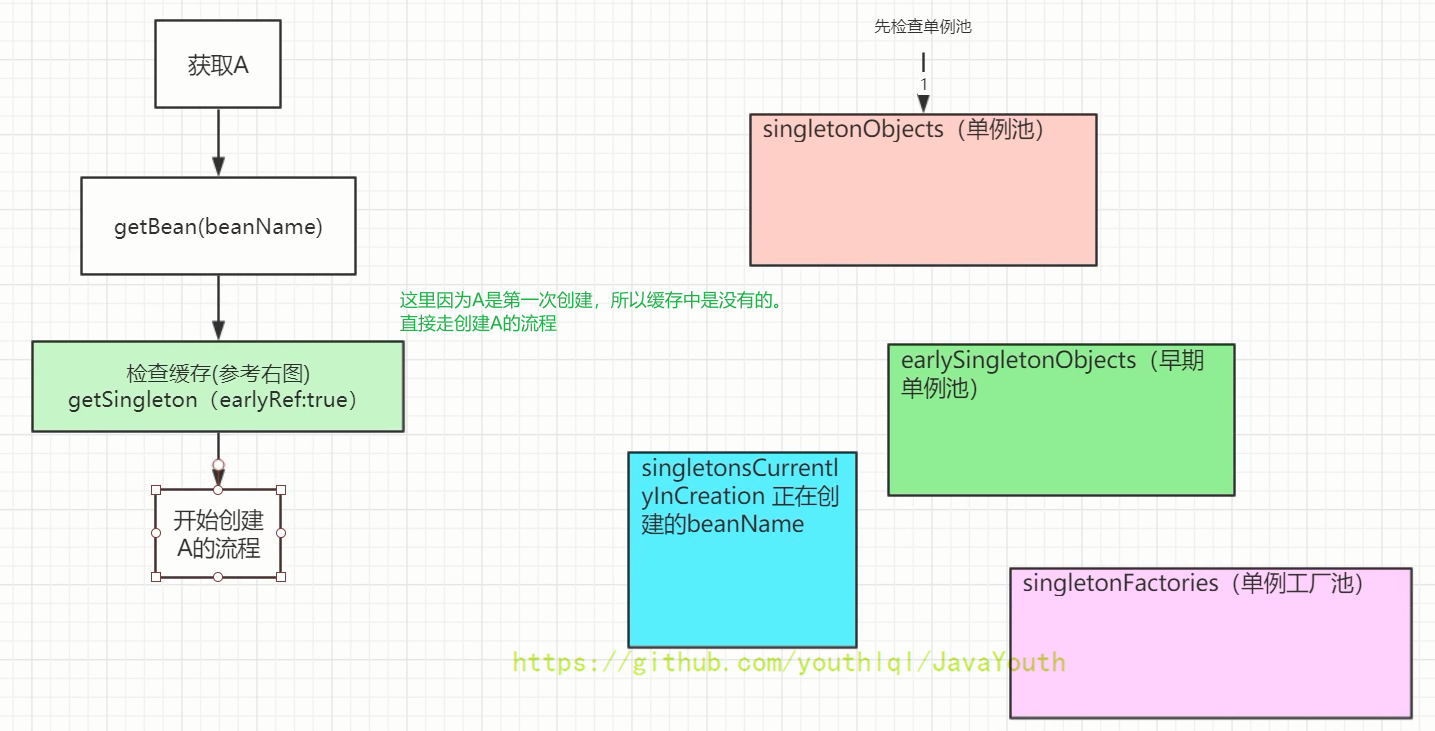
- 然后走到pos_2调用pos_5的
getSingleton()开始创建A的流程 - 在pos_5的
getSingleton()中走到pos_6的beforeSingletonCreation(),就变成下面这样
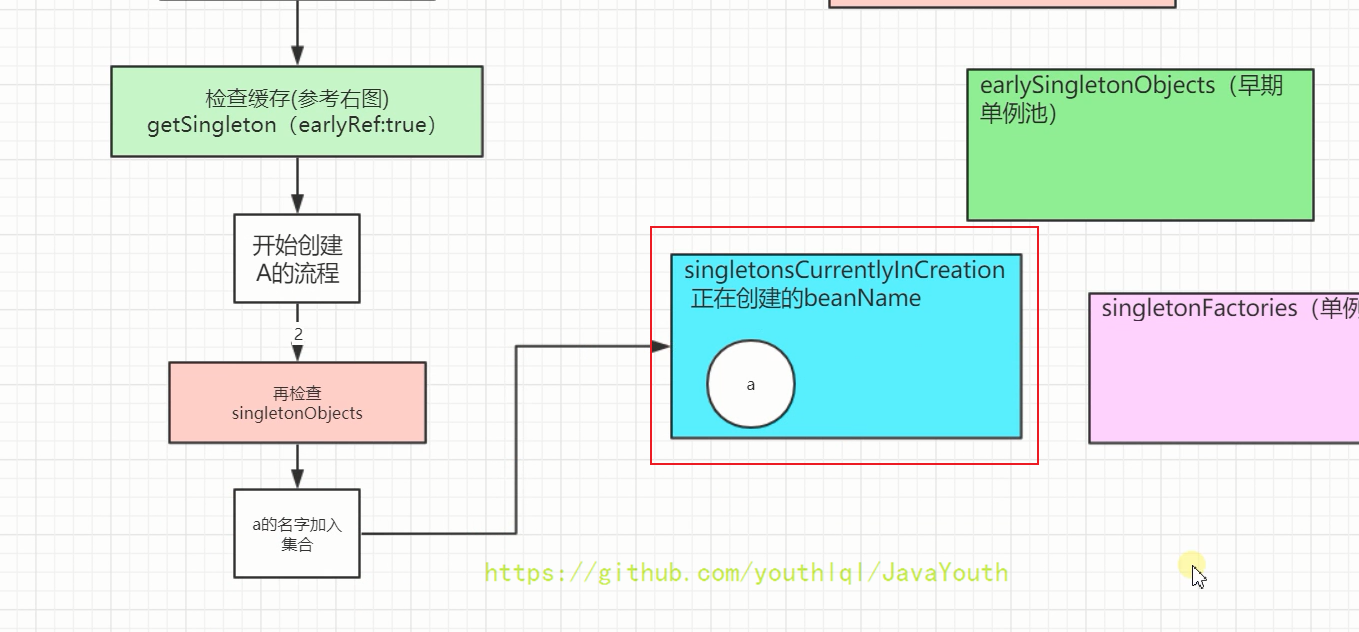
-
接着pos_7的会调用pos_2的lamda表达式里的
createbean(),里面再调用doCreateBean()。前面讲过不多说,最终调用A的无参构造(pos_8),创建完之后发现A的B属性是null。
5.在pos_9处的
addSingletonFactory()来准备解决循环引用
protected void addSingletonFactory(String beanName, ObjectFactory<?> singletonFactory) {
Assert.notNull(singletonFactory, "Singleton factory must not be null");
synchronized (this.singletonObjects) {
if (!this.singletonObjects.containsKey(beanName)) { //当前对象如果没有在单例池中
this.singletonFactories.put(beanName, singletonFactory);
this.earlySingletonObjects.remove(beanName);
this.registeredSingletons.add(beanName);
}
}
}
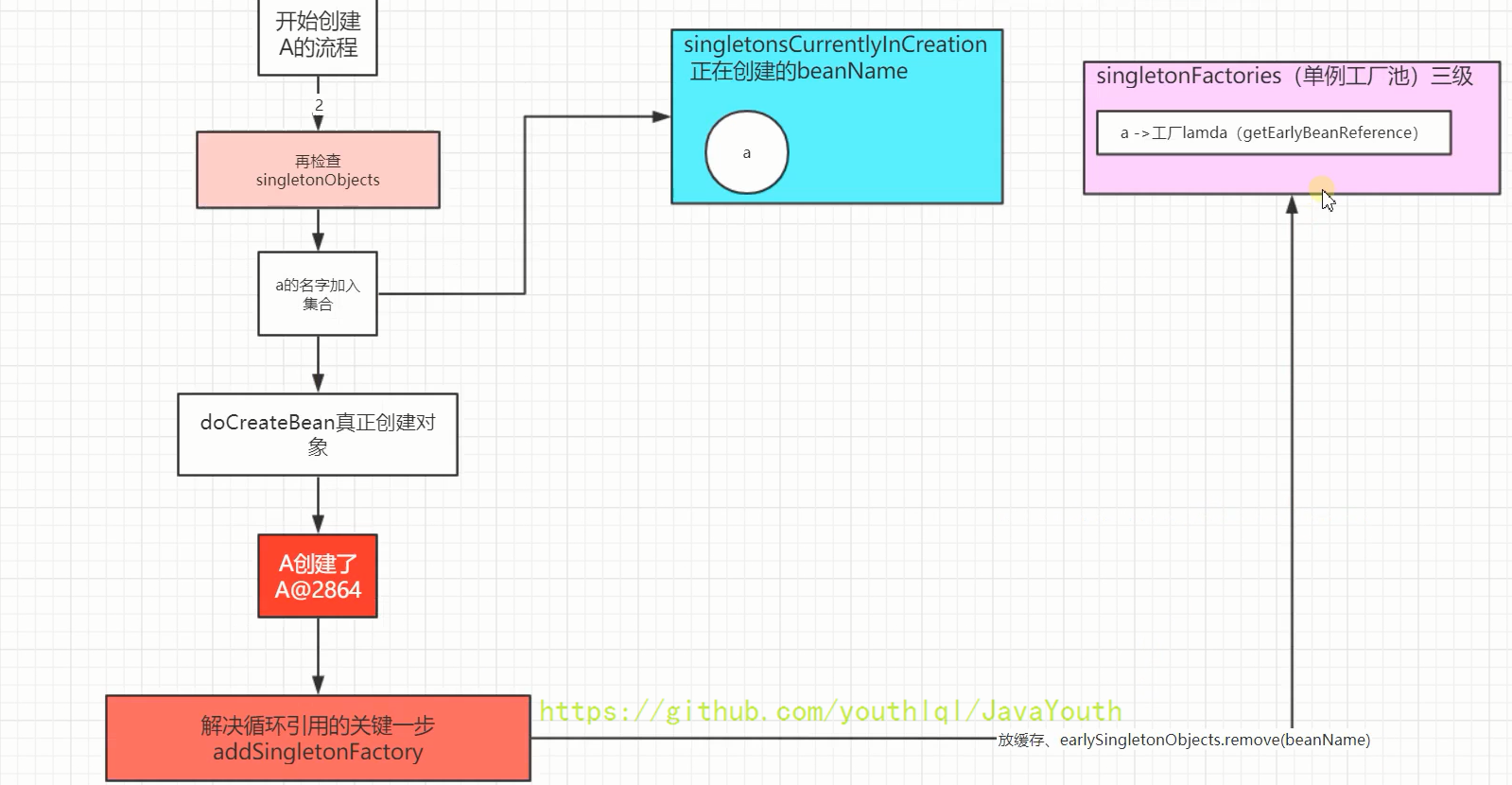
- 接着在pos_10处的
populateBean()开始给属性赋值,这一步就是要把B b自动装配进来。主要是
protected void populateBean(String beanName, RootBeanDefinition mbd, @Nullable BeanWrapper bw) {
if (bw == null) {
if (mbd.hasPropertyValues()) {
throw new BeanCreationException(
mbd.getResourceDescription(), beanName, "Cannot apply property values to null instance");
}
else {
// Skip property population phase for null instance.
return;
}
}
// @Autowired赋值也在这里(但是没做事)。可以中断初始化行为; 在属性赋值之前,后置处理器可以提前准备些东西 Give any InstantiationAwareBeanPostProcessors the opportunity to modify the
if (!mbd.isSynthetic() && hasInstantiationAwareBeanPostProcessors()) {
for (InstantiationAwareBeanPostProcessor bp : getBeanPostProcessorCache().instantiationAware) {
if (!bp.postProcessAfterInstantiation(bw.getWrappedInstance(), beanName)) {
return;
}
}
} //以上的后置处理器可以中断以下的行为
PropertyValues pvs = (mbd.hasPropertyValues() ? mbd.getPropertyValues() : null);
int resolvedAutowireMode = mbd.getResolvedAutowireMode();
if (resolvedAutowireMode == AUTOWIRE_BY_NAME || resolvedAutowireMode == AUTOWIRE_BY_TYPE) {
// ...
}
boolean hasInstAwareBpps = hasInstantiationAwareBeanPostProcessors();
boolean needsDepCheck = (mbd.getDependencyCheck() != AbstractBeanDefinition.DEPENDENCY_CHECK_NONE);
PropertyDescriptor[] filteredPds = null;
if (hasInstAwareBpps) {
if (pvs == null) {
pvs = mbd.getPropertyValues(); //xml中property标签指定的
} //使用后置处理器处理属性
for (InstantiationAwareBeanPostProcessor bp : getBeanPostProcessorCache().instantiationAware) {
PropertyValues pvsToUse = bp.postProcessProperties(pvs, bw.getWrappedInstance(), beanName);
if (pvsToUse == null) {
if (filteredPds == null) {
filteredPds = filterPropertyDescriptorsForDependencyCheck(bw, mbd.allowCaching);
}
pvsToUse = bp.postProcessPropertyValues(pvs, filteredPds, bw.getWrappedInstance(), beanName);
if (pvsToUse == null) {
return;
}
}
pvs = pvsToUse; //封装了当前bean的所有属性名和值,可以由后置处理器处理得到
}
}
// ...
if (pvs != null) { //把以前处理好的PropertyValues给bean里面设置一下。主要是上面步骤没有给bean里面设置的属性
applyPropertyValues(beanName, mbd, bw, pvs); //xml版的所有配置会来到这里给属性赋值
}
}
通过前面讲过的AutowiredAnnotationBeanPostProcessor来注入B,最后发现要调用setB方法给B赋值
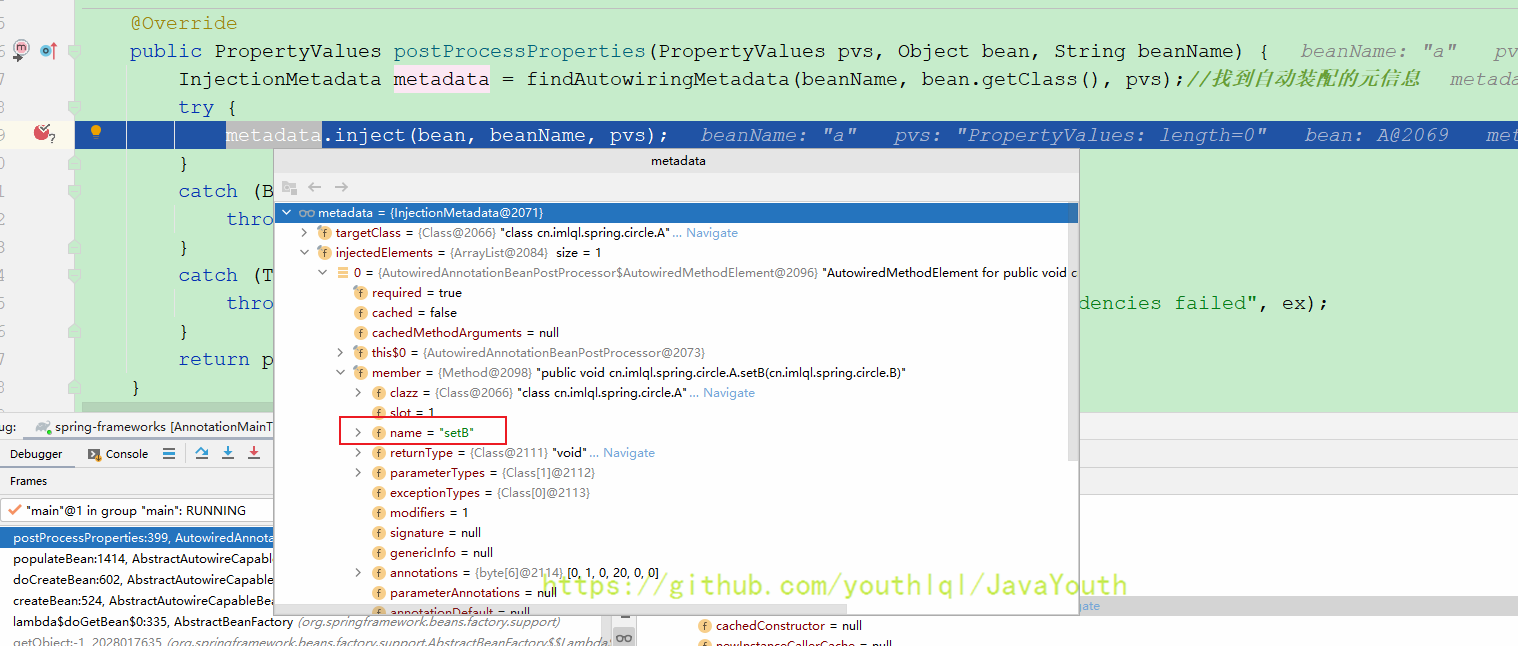
- 继续走,发现要想获得B还是要调用getBean
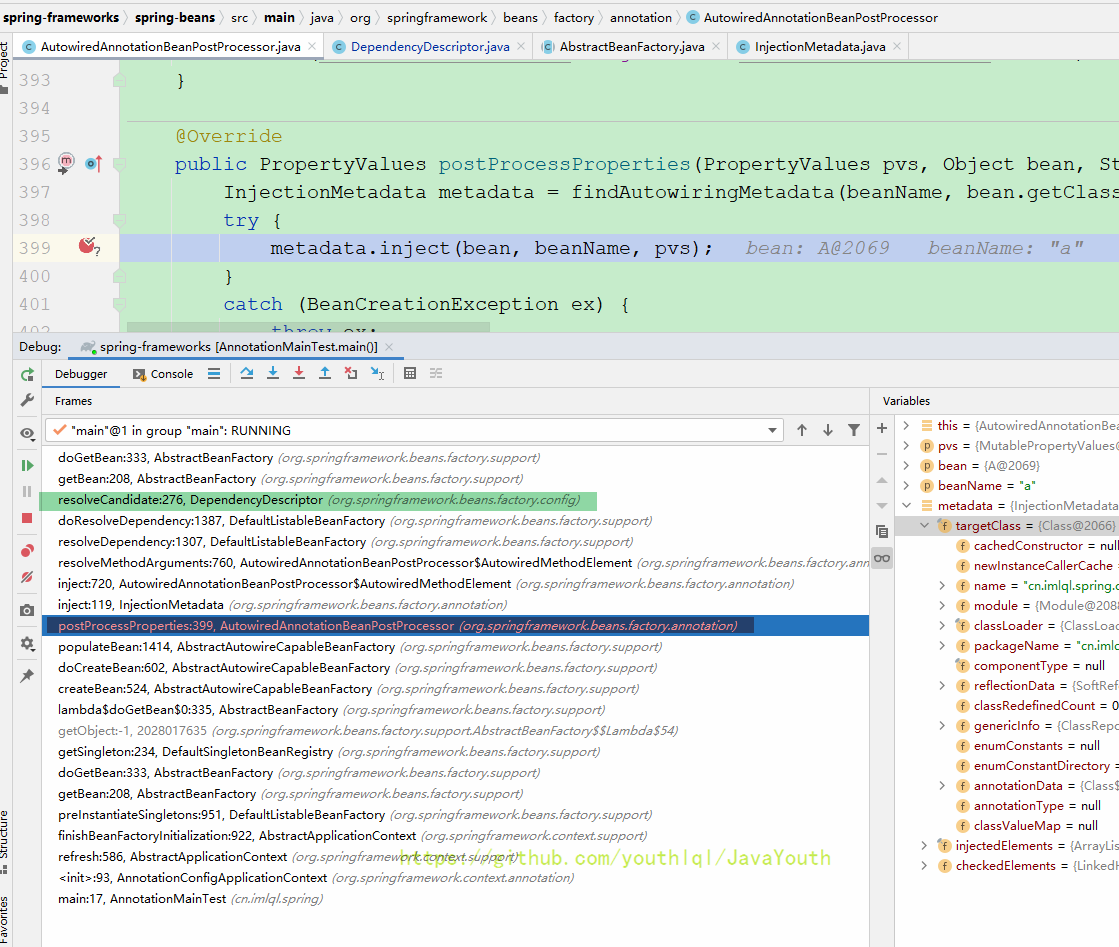
public Object resolveCandidate(String beanName, Class<?> requiredType, BeanFactory beanFactory)
throws BeansException {
return beanFactory.getBean(beanName); //所有自动注入的属性都是beanFactory.getBean(beanName);的结果
}
然后图就是这样子
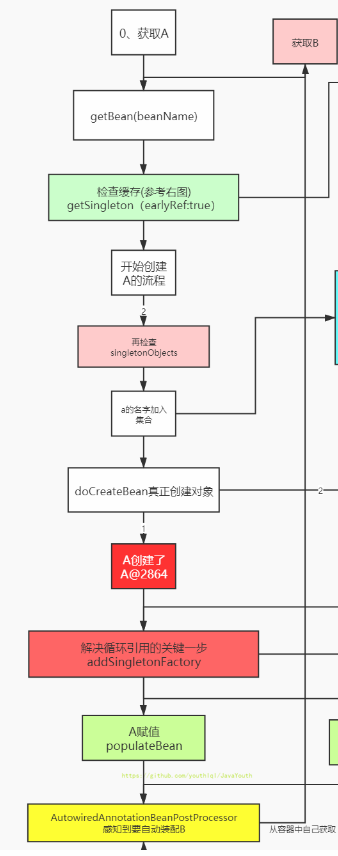
- B也是走这一套
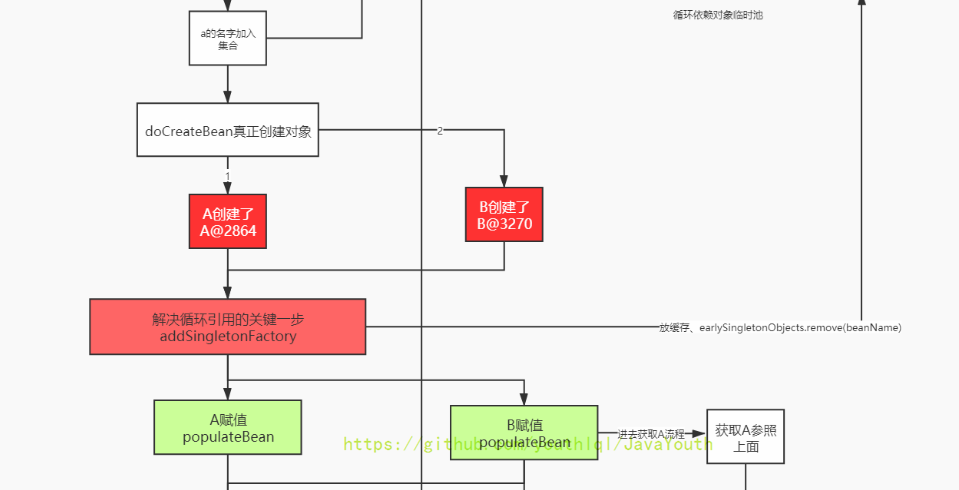
- B为了获取A,还要再走一次getBean()流程,最终还是走到
//☆☆☆ pos_4
@Nullable //双检查锁
protected Object getSingleton(String beanName, boolean allowEarlyReference) {
//先检查单例缓存池,获取当前对象 Quick check for existing instance without full singleton lock
Object singletonObject = this.singletonObjects.get(beanName); //一级缓存
if (singletonObject == null && isSingletonCurrentlyInCreation(beanName)) { //如果当前bean正在创建过程中,而且缓存中没有则继续
singletonObject = this.earlySingletonObjects.get(beanName); //二级
if (singletonObject == null && allowEarlyReference) {
synchronized (this.singletonObjects) {
// Consistent creation of early reference within full singleton lock
singletonObject = this.singletonObjects.get(beanName);
if (singletonObject == null) {
singletonObject = this.earlySingletonObjects.get(beanName);
if (singletonObject == null) {
ObjectFactory<?> singletonFactory = this.singletonFactories.get(beanName); //三级
if (singletonFactory != null) {
singletonObject = singletonFactory.getObject();// 用那个lamda表达式拿对象
this.earlySingletonObjects.put(beanName, singletonObject);
this.singletonFactories.remove(beanName);
}
}
}
}
}
}
return singletonObject;
}

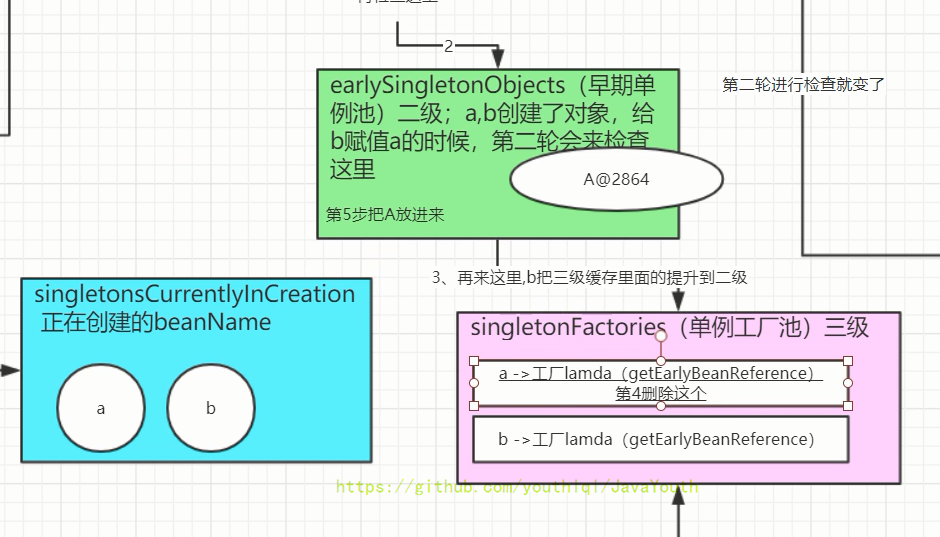
-
得到A之后,B赋值结束。B进入初始化
populateBean(beanName, mbd, instanceWrapper); //给创建好的对象每个属性进行赋值,@Autowired发生在这里 exposedObject = initializeBean(beanName, exposedObject, mbd);//初始化bean -
B初始化完之后,回到getSingleton,把自己放到单例池里

protected void addSingleton(String beanName, Object singletonObject) {
synchronized (this.singletonObjects) {
this.singletonObjects.put(beanName, singletonObject);
this.singletonFactories.remove(beanName);
this.earlySingletonObjects.remove(beanName);
this.registeredSingletons.add(beanName);
}
}
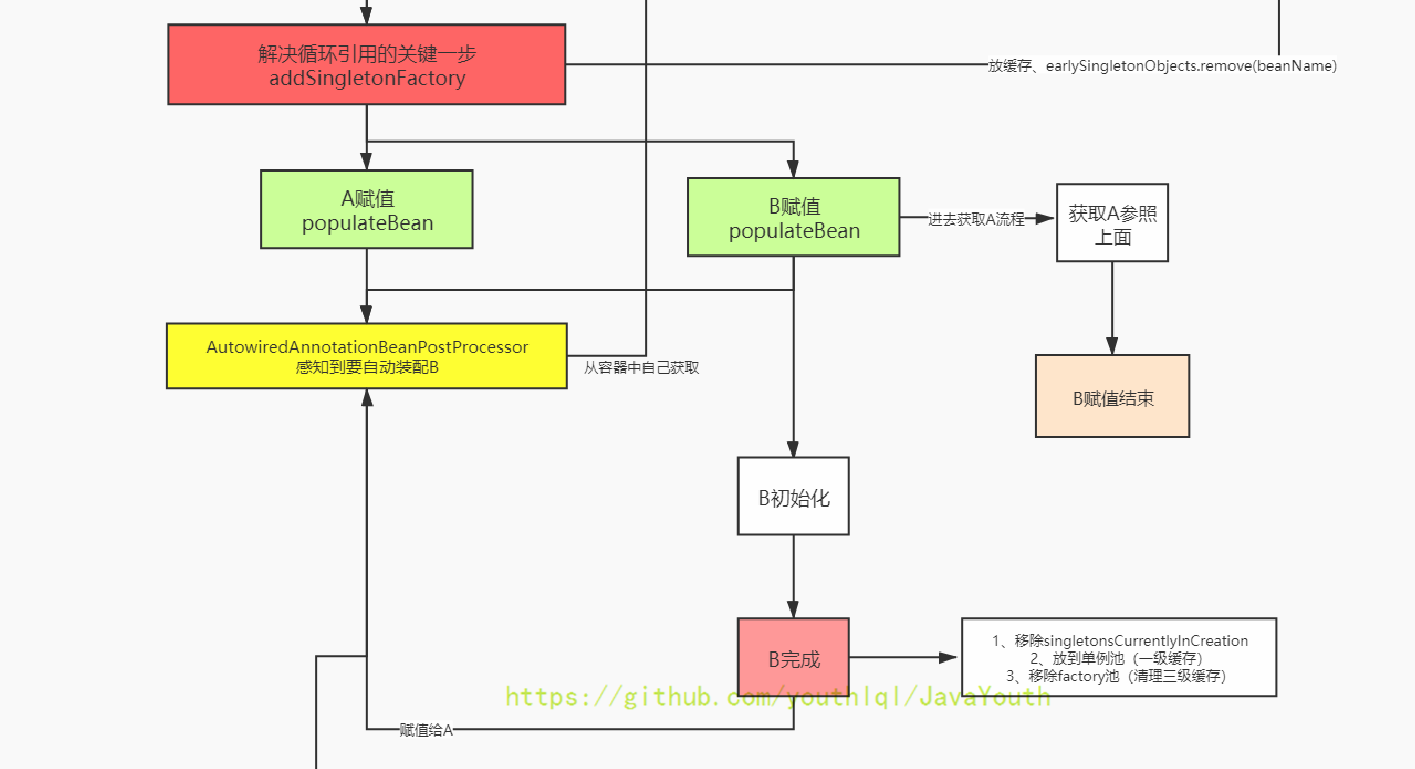
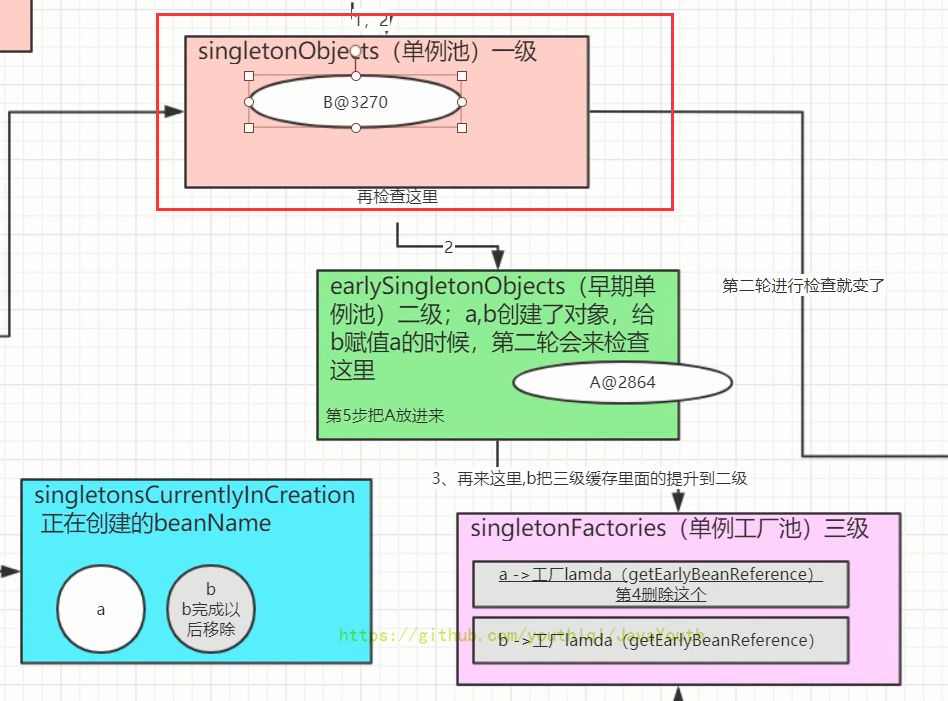
- B全部结束之后回到A的流程,A赋值工作结束了,然后就开始A的初始化。初始化的过程中

protected void addSingleton(String beanName, Object singletonObject) {
synchronized (this.singletonObjects) {
this.singletonObjects.put(beanName, singletonObject); //加到一级
this.singletonFactories.remove(beanName); //移除三级
this.earlySingletonObjects.remove(beanName); //移除二级
this.registeredSingletons.add(beanName);
}
}

全部的流程图
